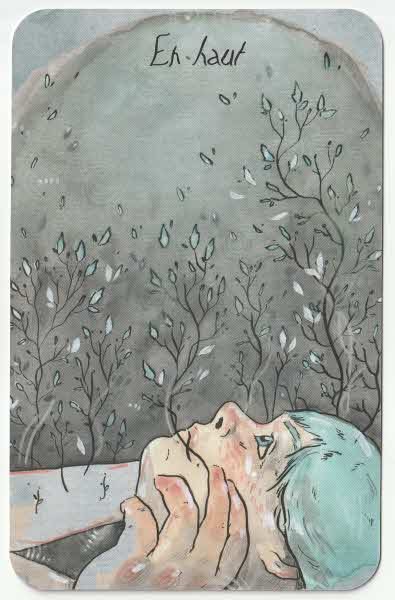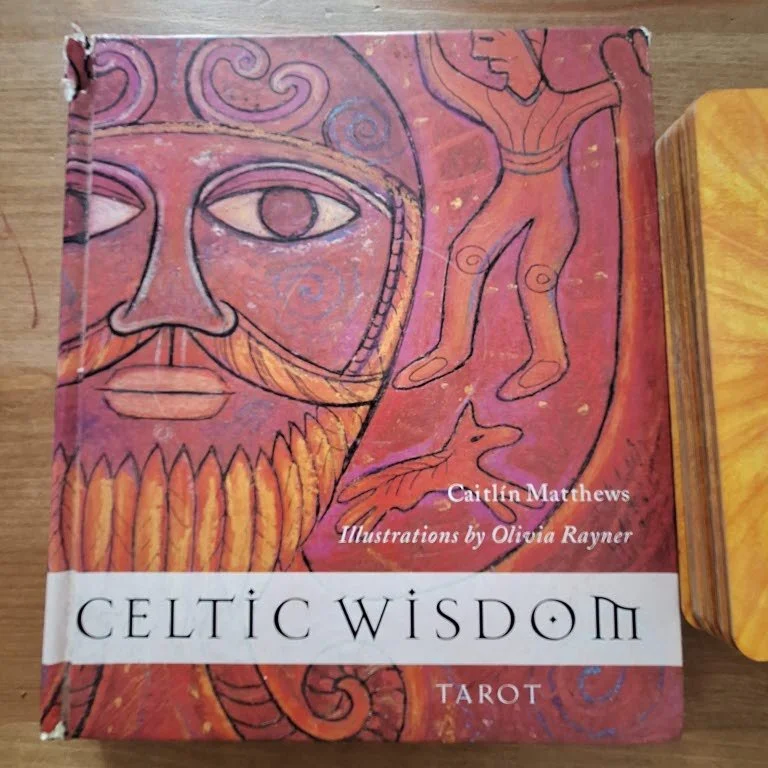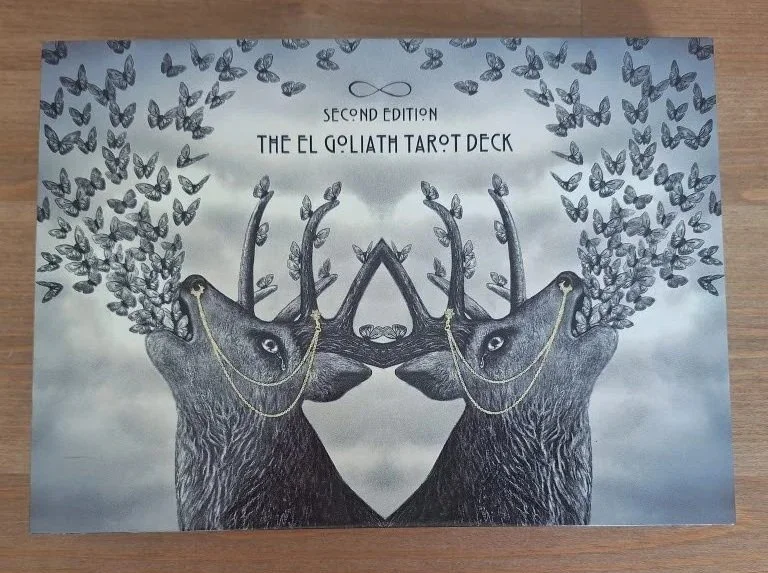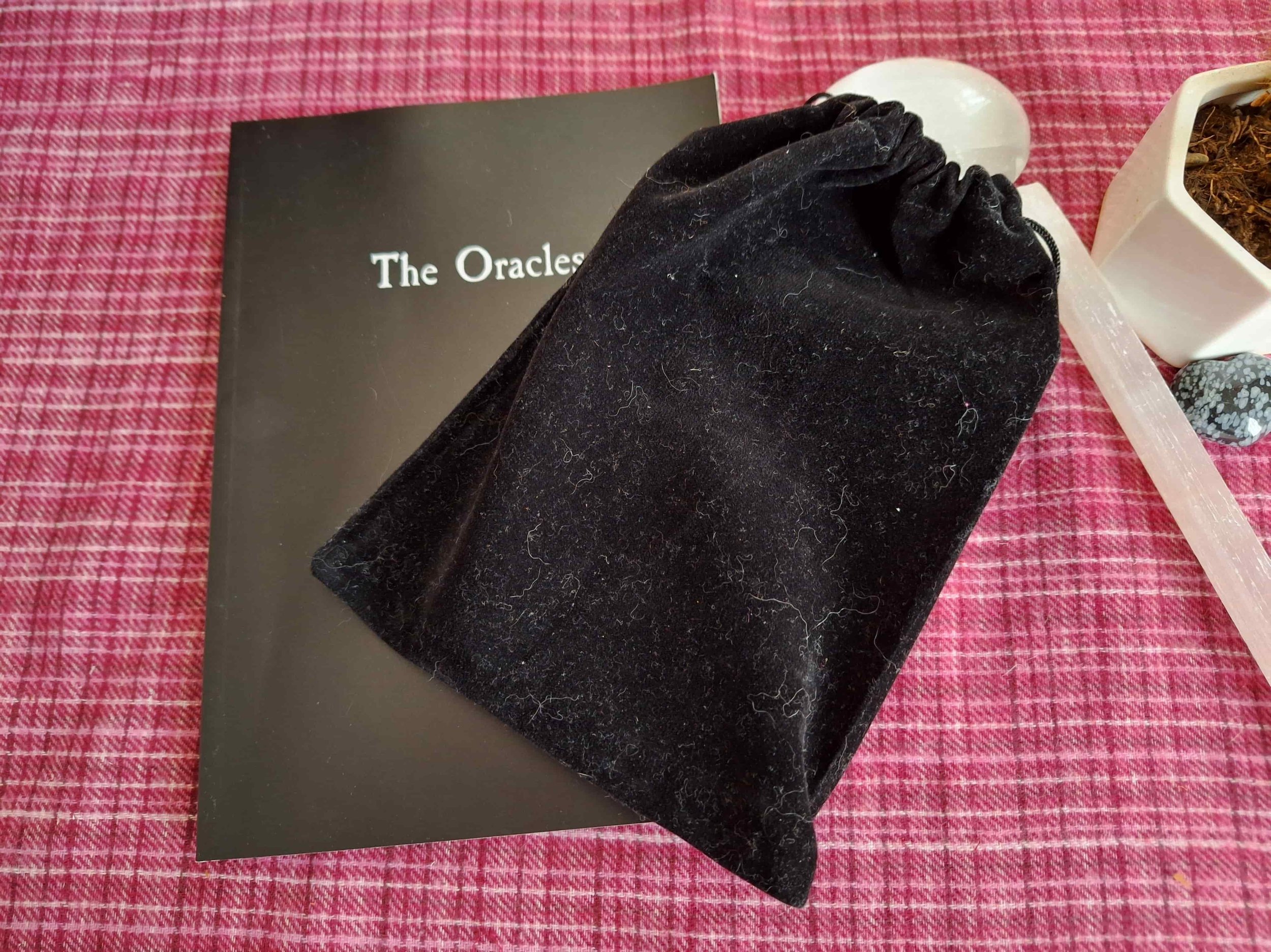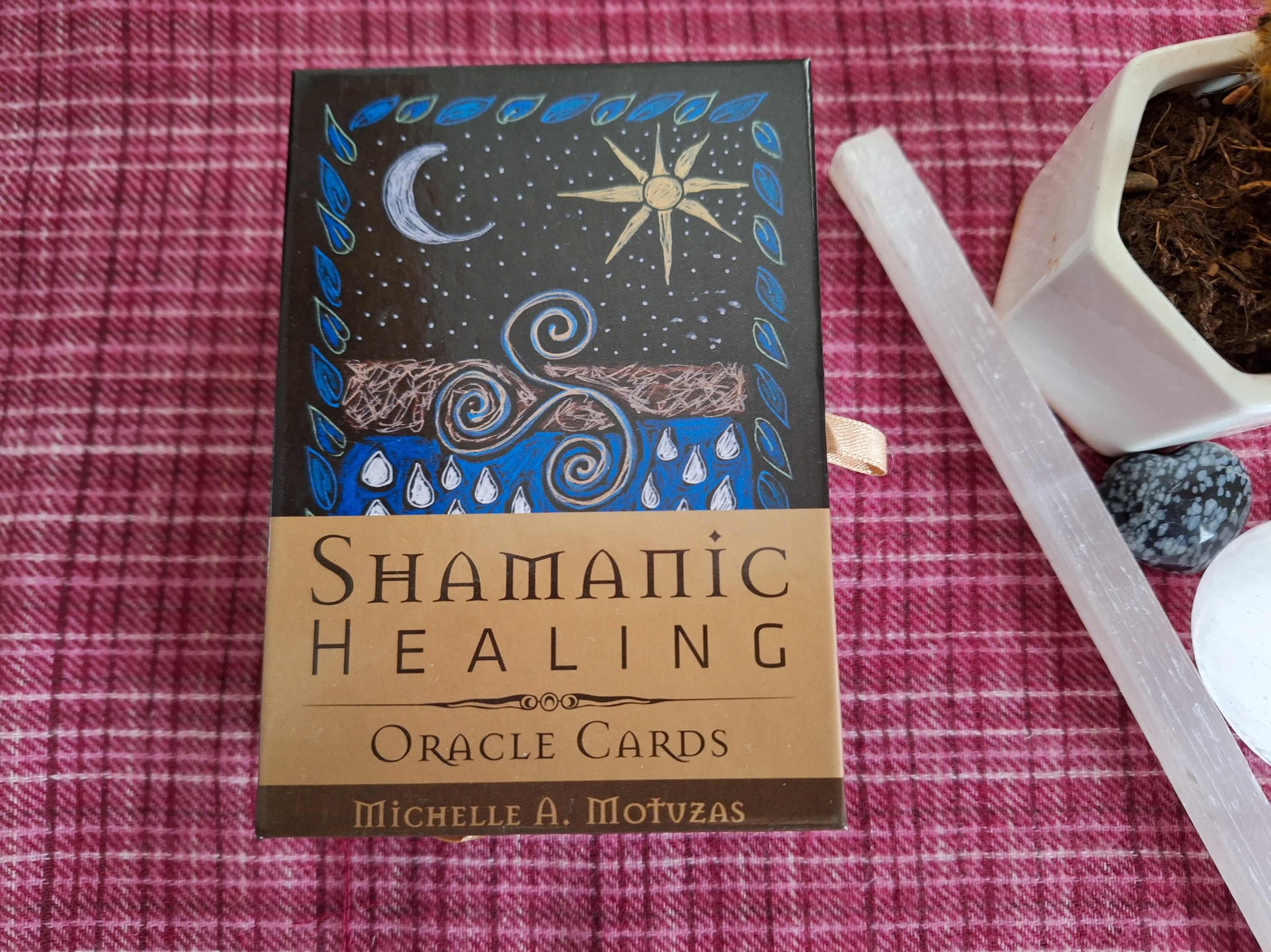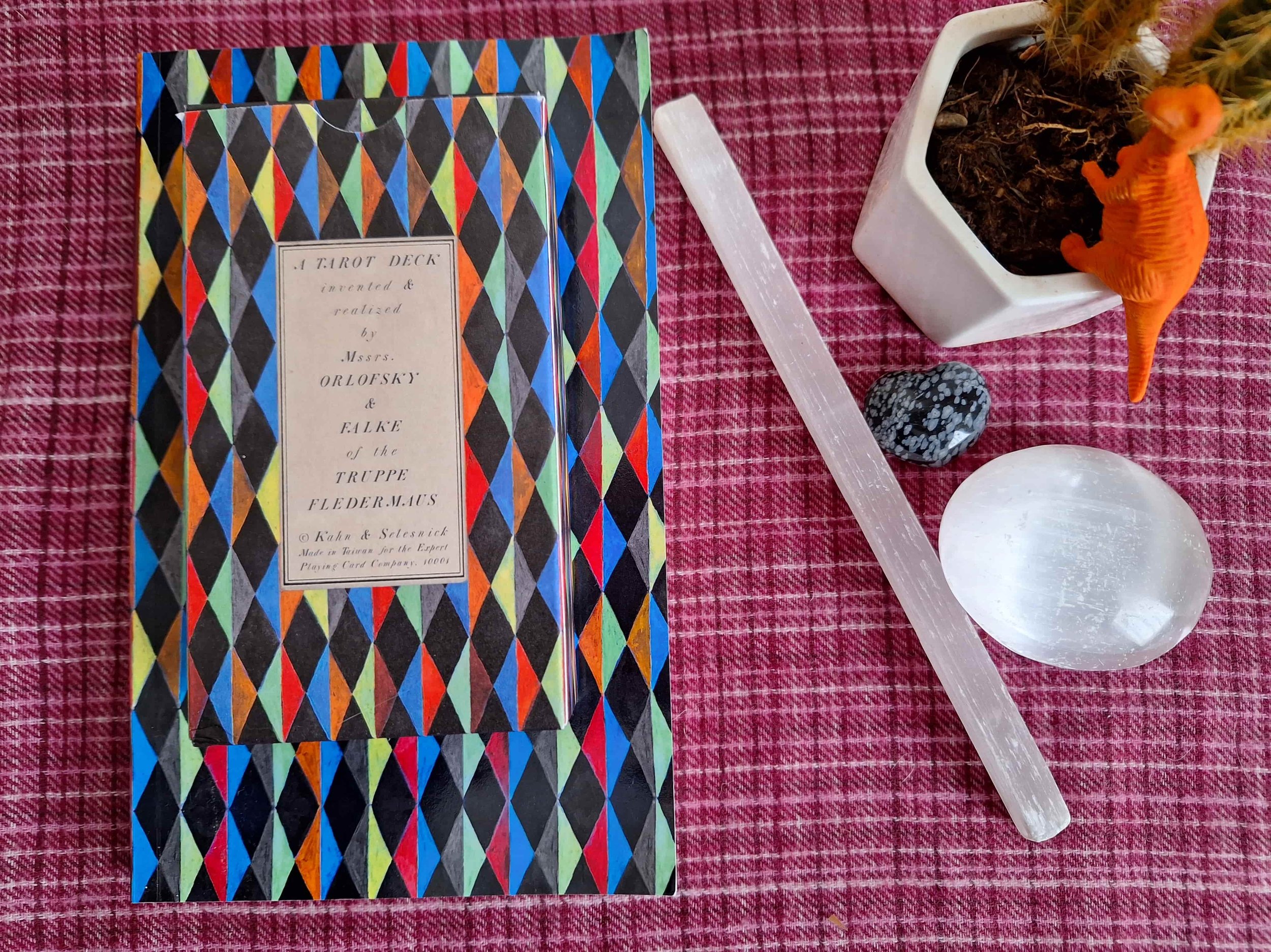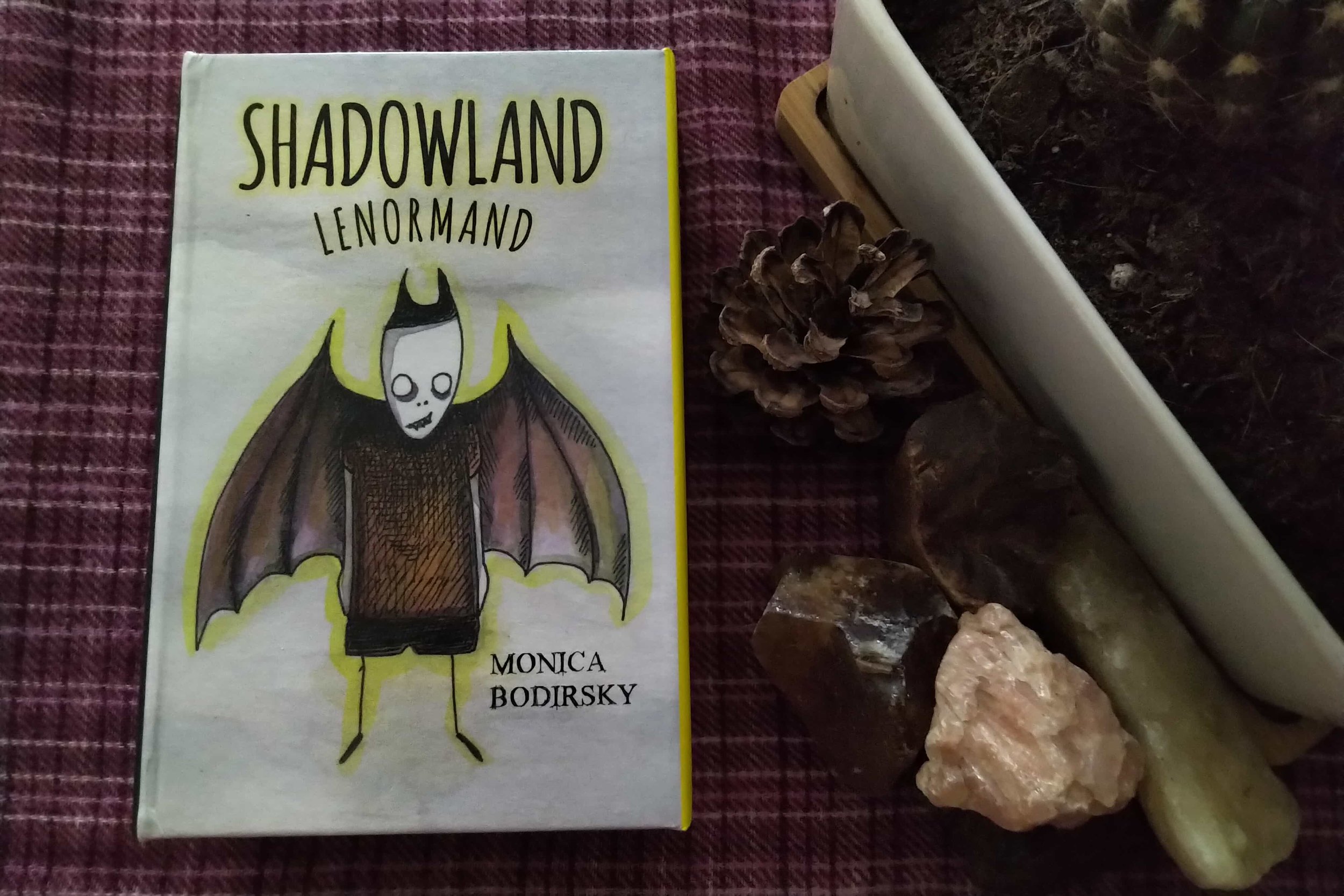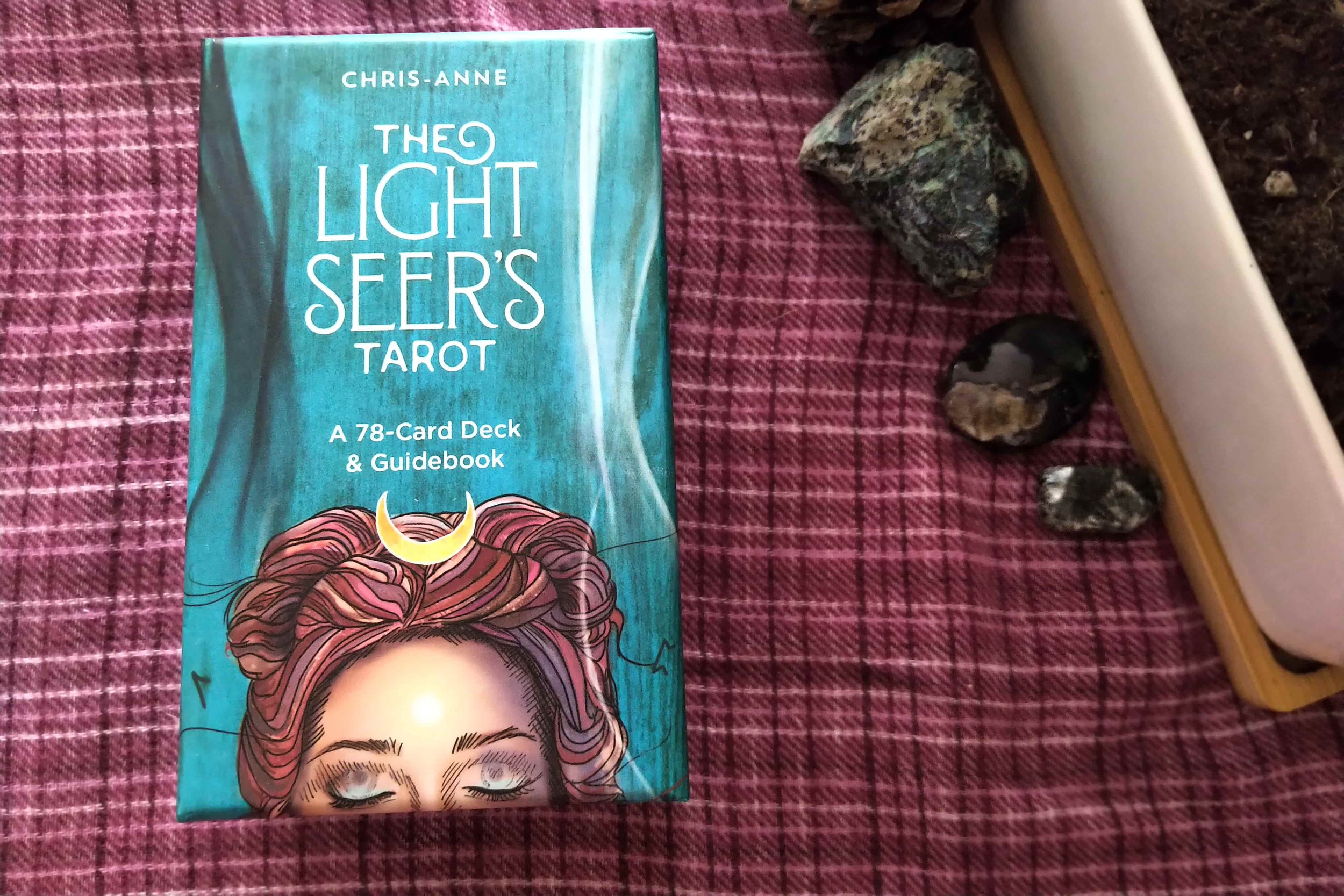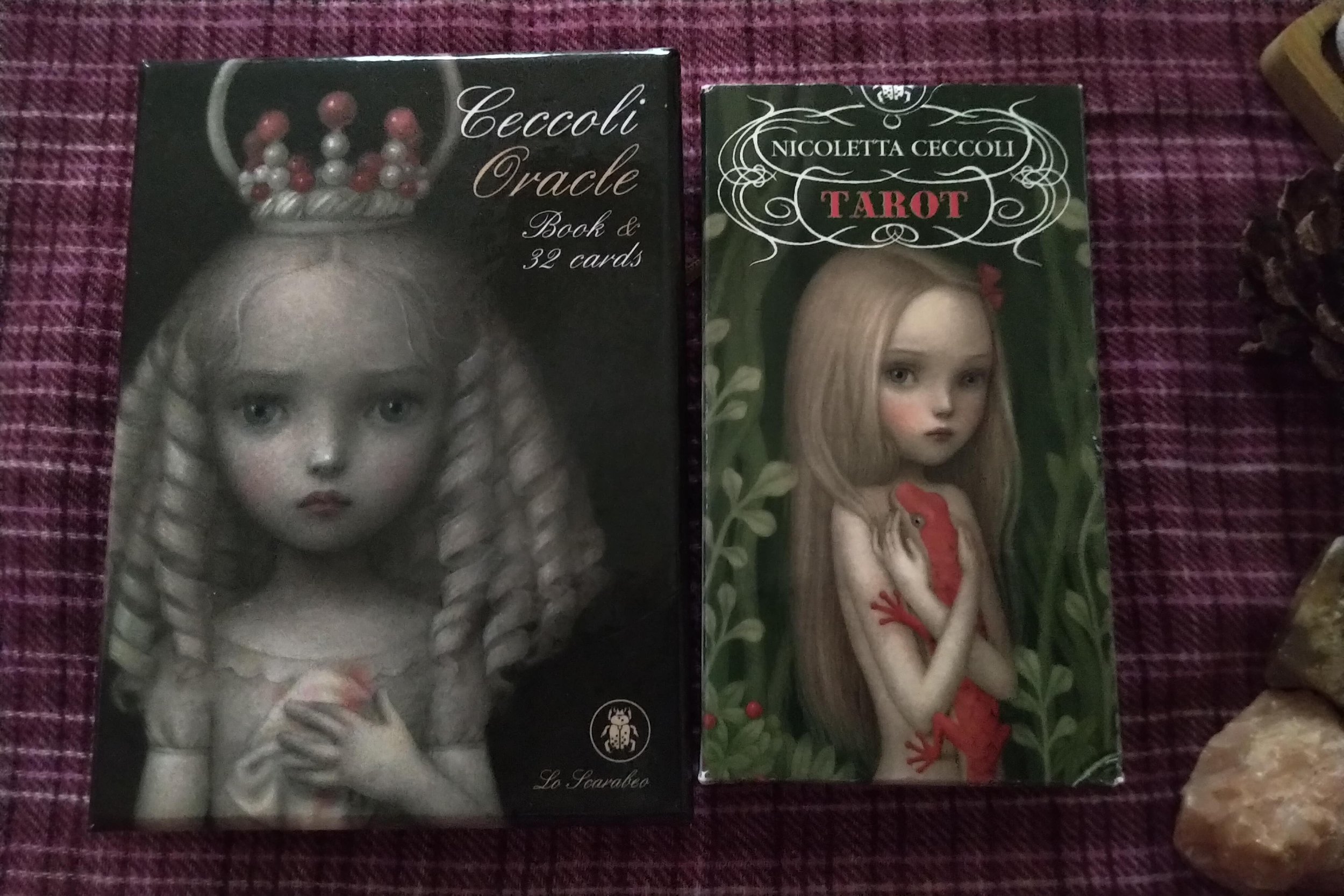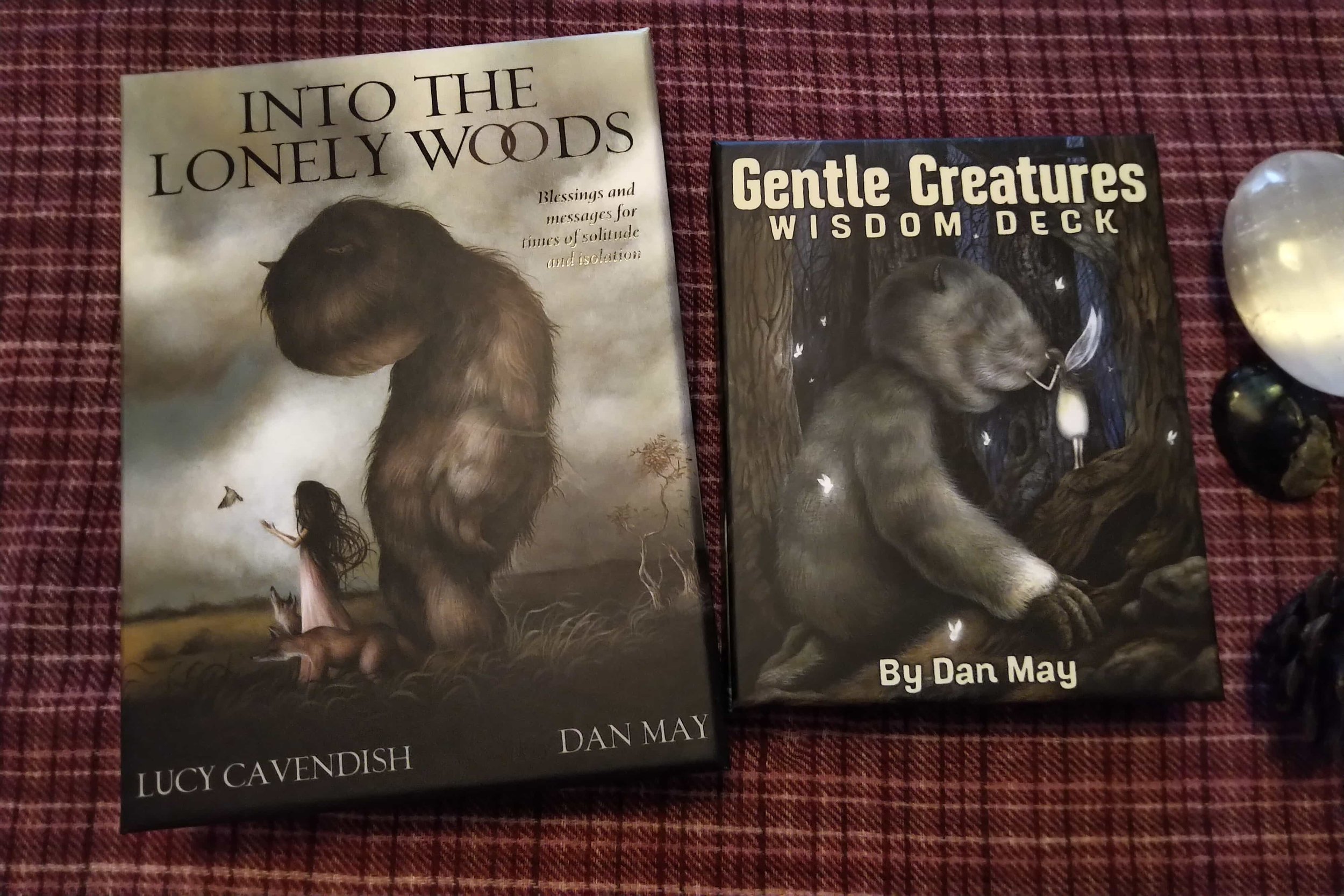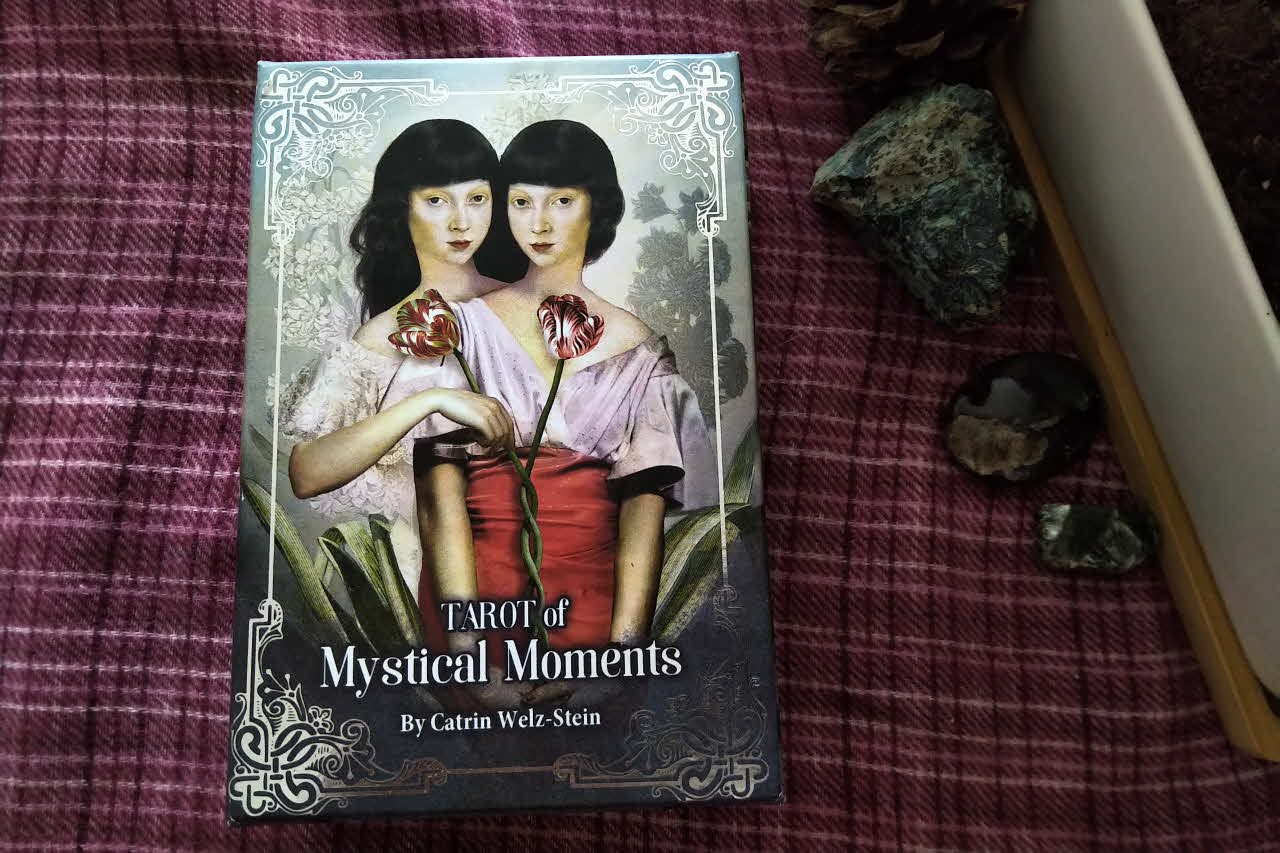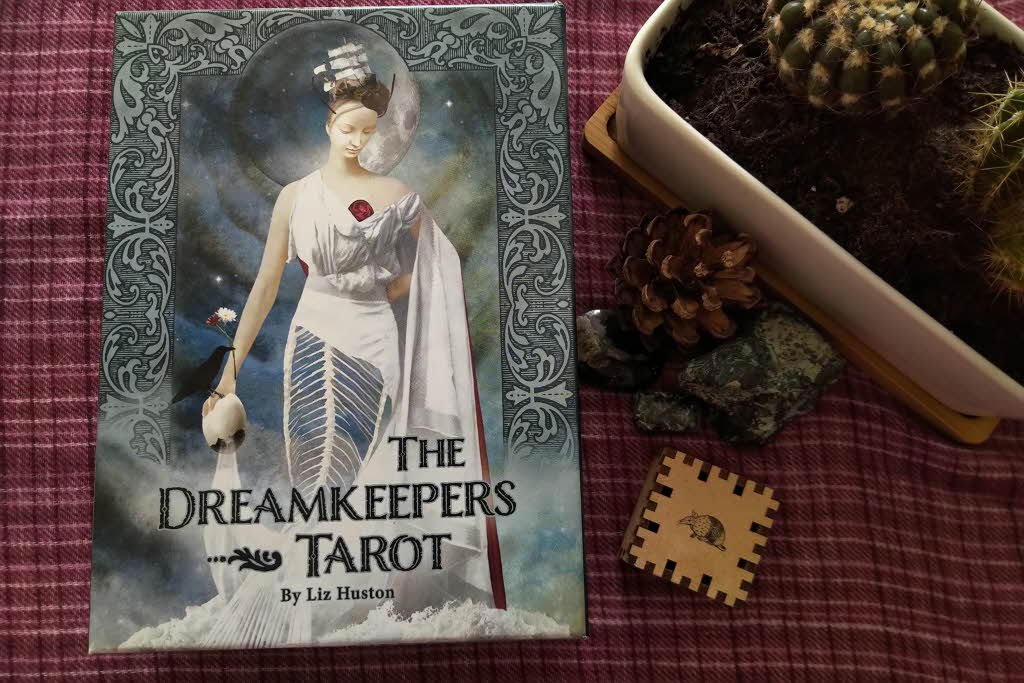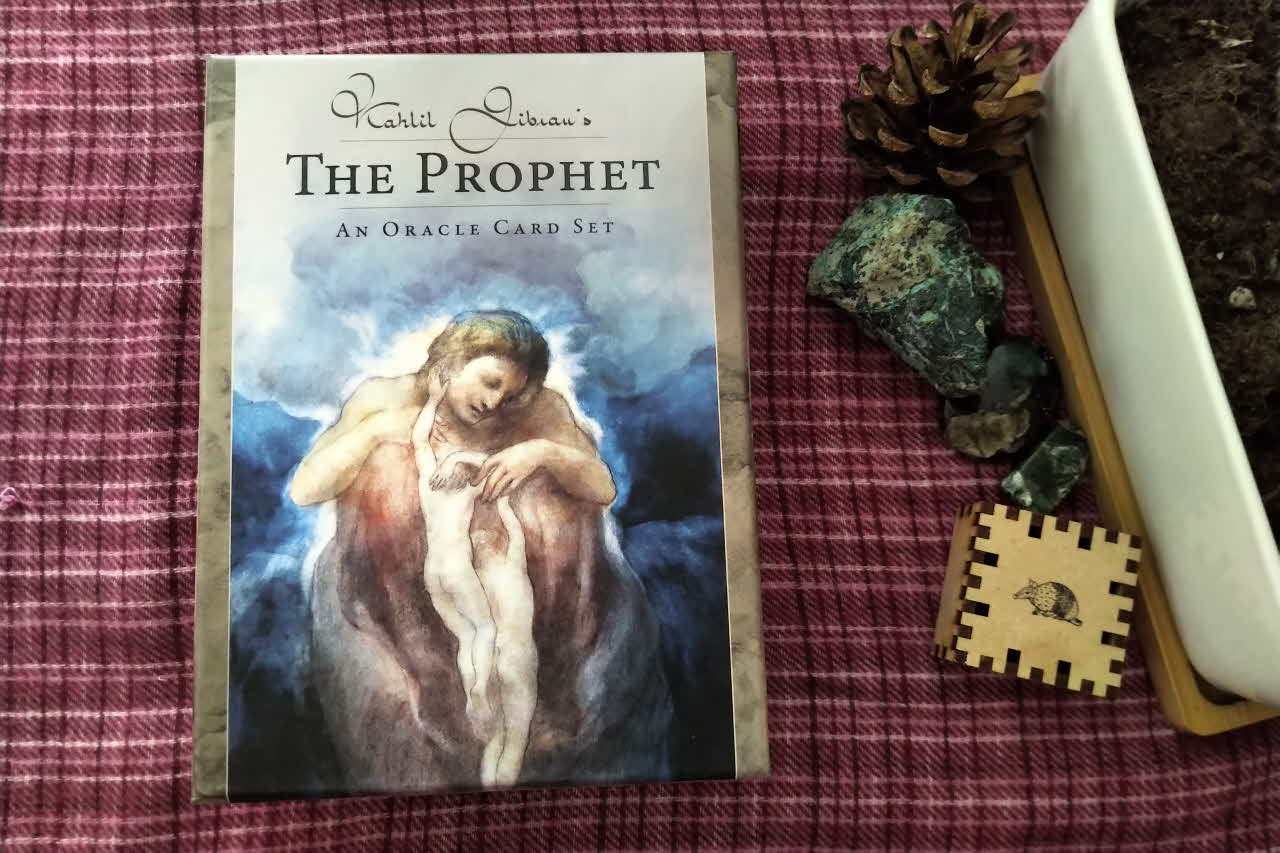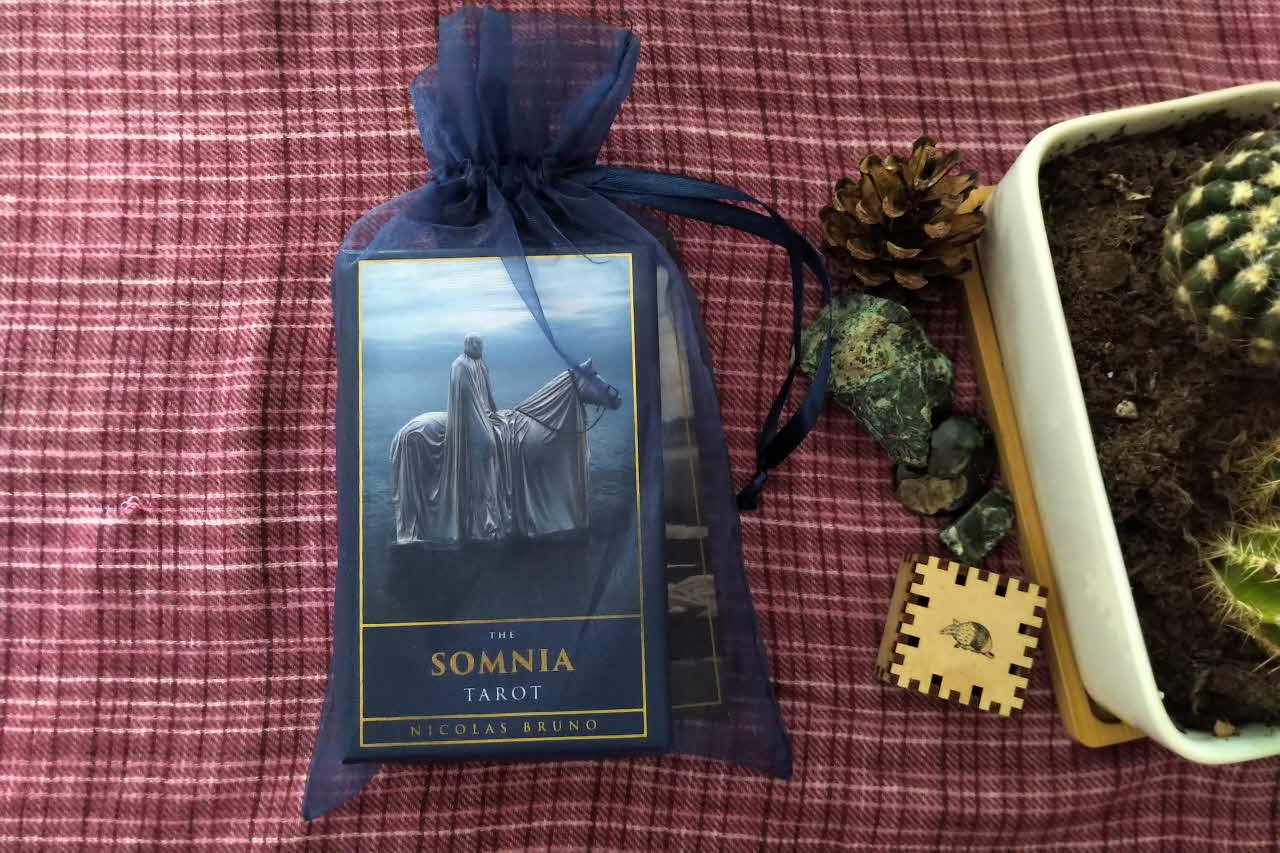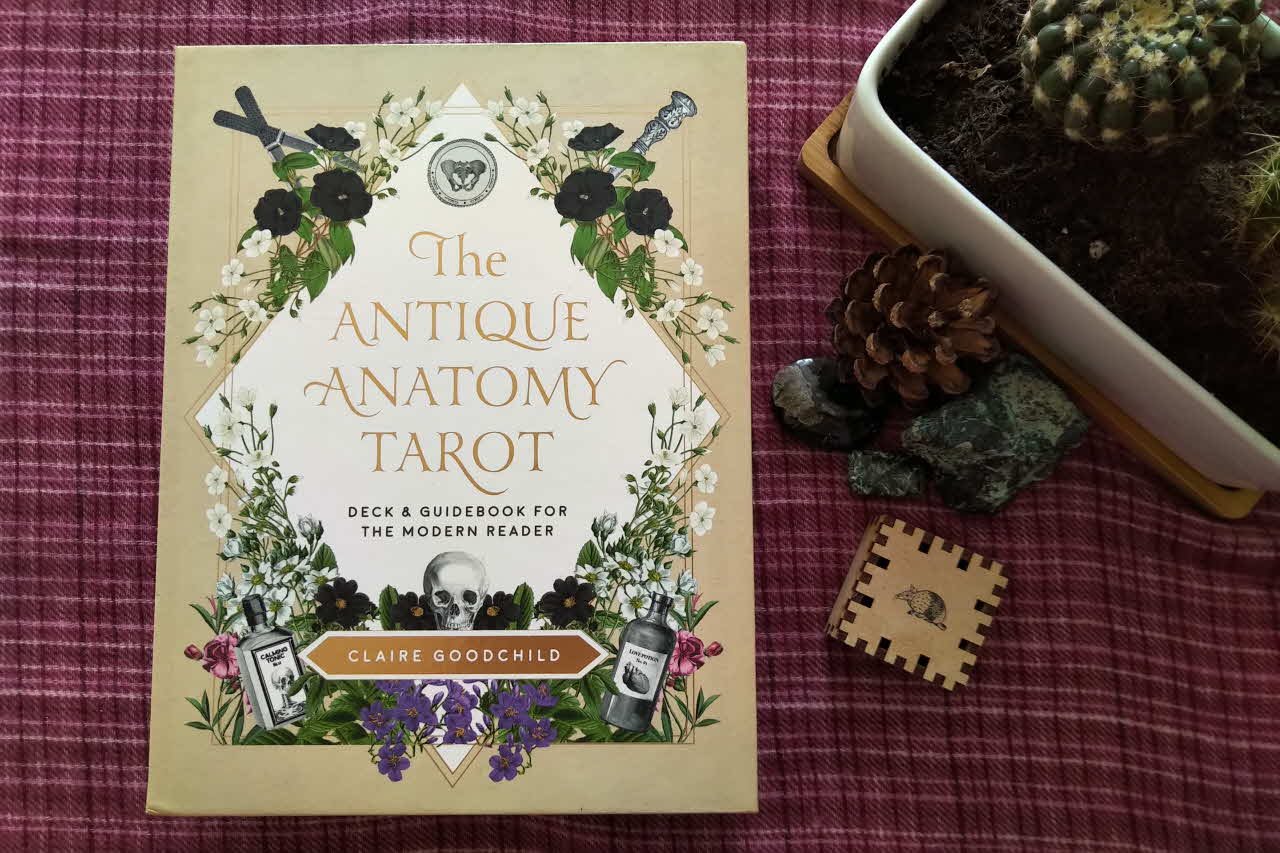Le Tarot aux Ramures Étranges
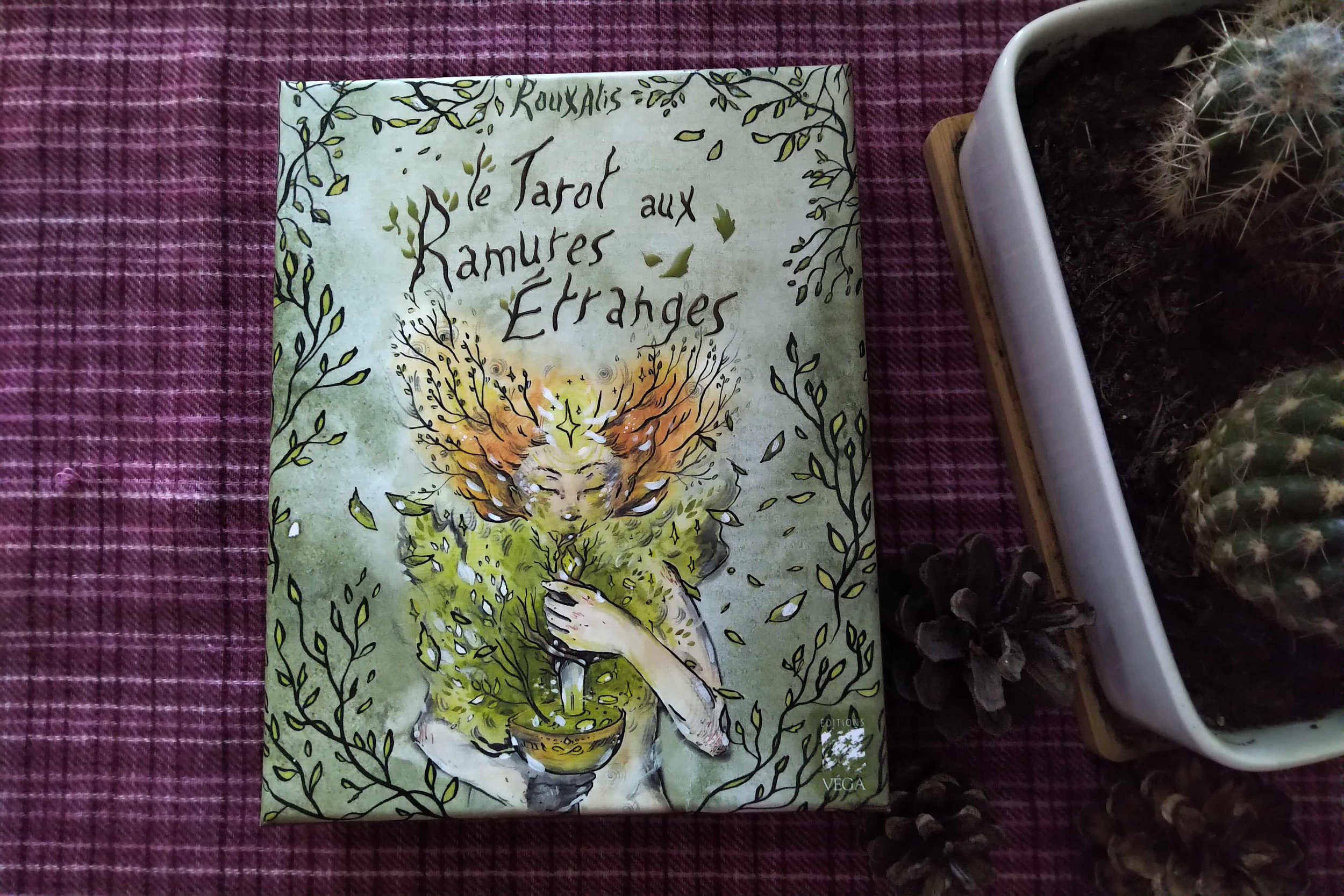
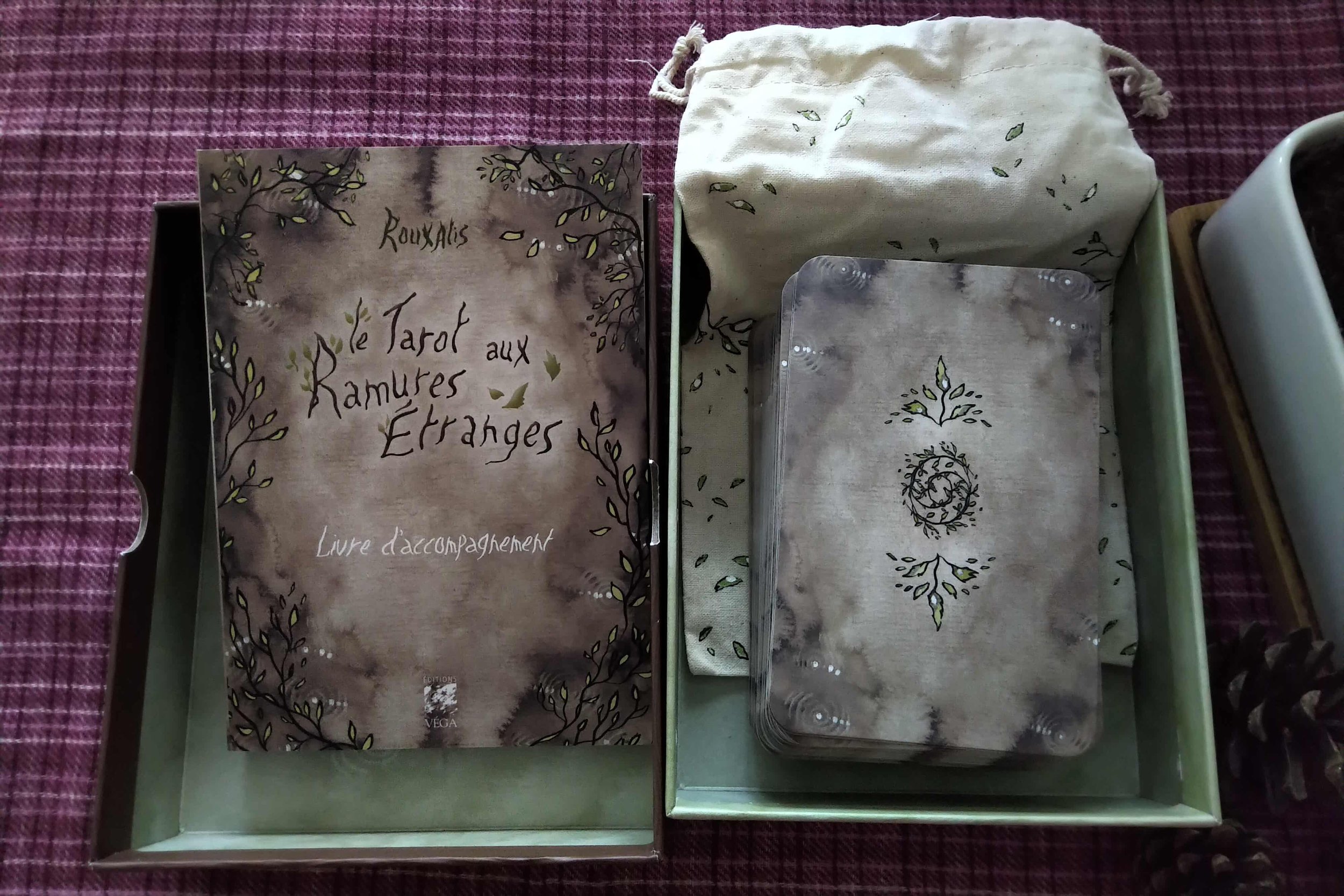
Le Tarot aux Ramures Étranges (The Strange Antlers Tarot, Tarot of the Strange Antlers) was published in April 2022. The author/illustrator is Alisa Marazyuk, and she uses the name Rouxalis as the author. It comes in a solid box with a lift-off lid, and the guidebook is a respectable size. There’s no box insert to keep the cards cosy, but a cloth bag is included in the set and makes for a nice finishing touch. The cards are thick and slightly larger than average, which makes for a hefty handful. I need to tell you that my French is rustier than a centuries-old horseshoe found in the middle of a field. I’ve bought this deck purely for the artwork, and I’ll have to rely on various internet translation tools to fill in the blanks. There are no keywords given for any of the cards. This could be French tradition, or it could be that Alisa wanted to create a more mature deck. I have no idea.
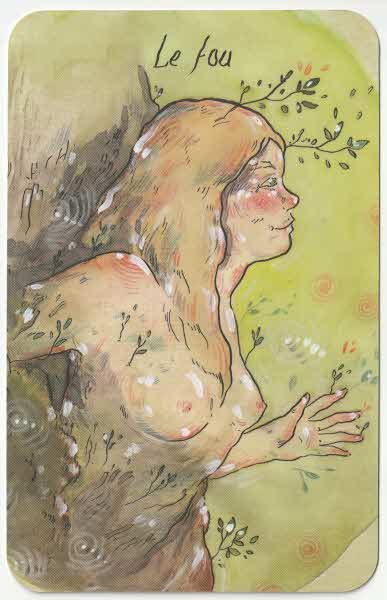
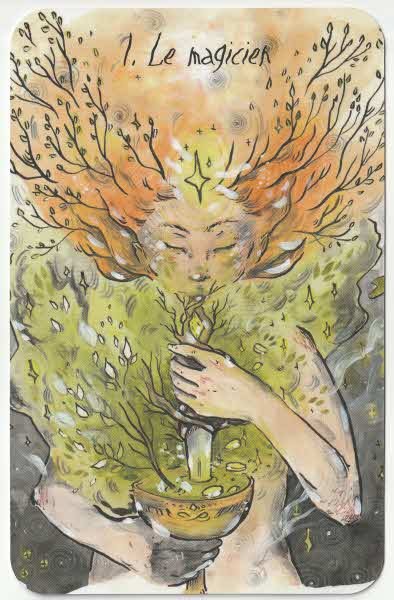
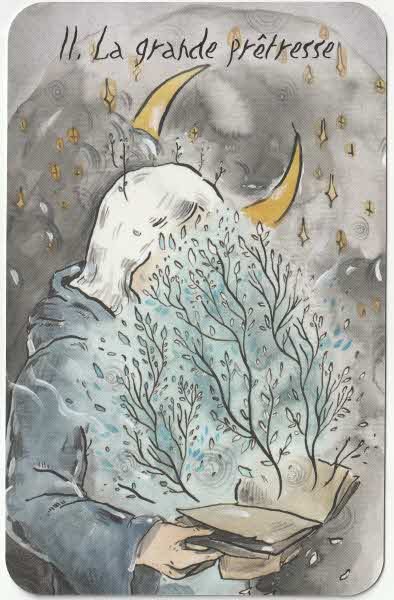

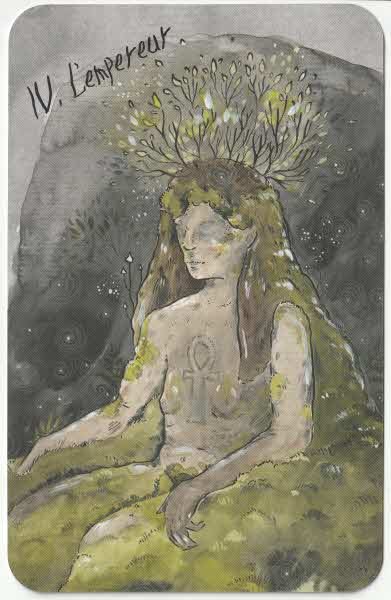

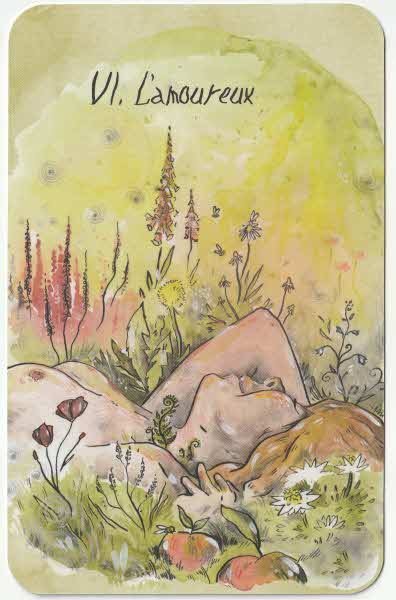
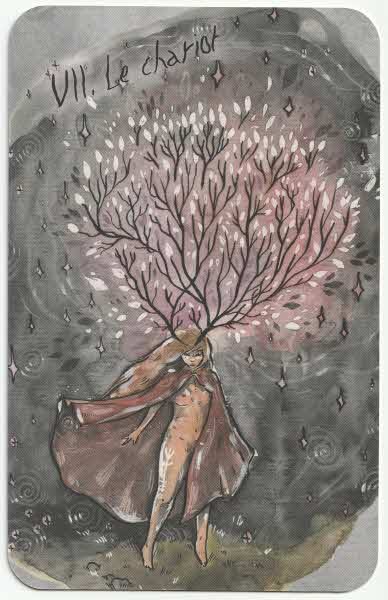
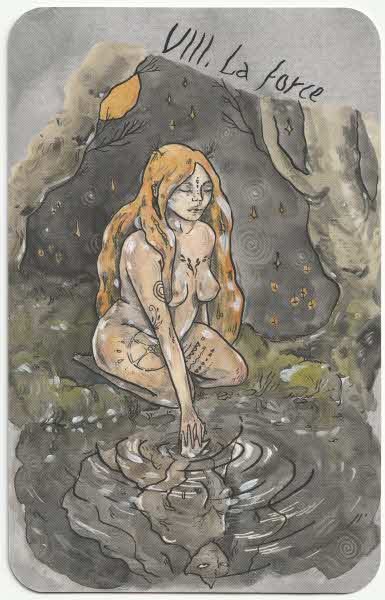
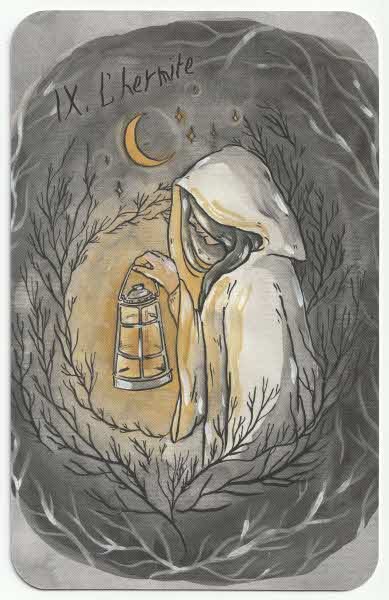
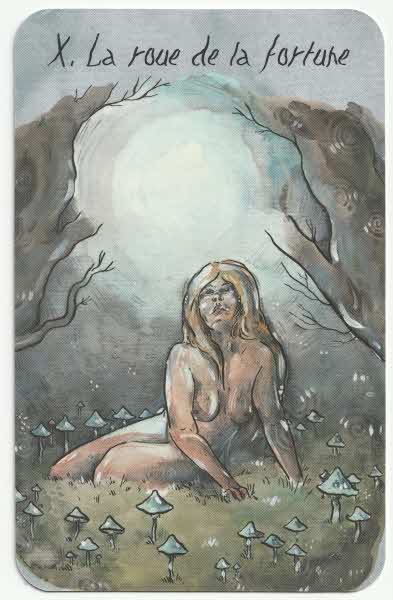
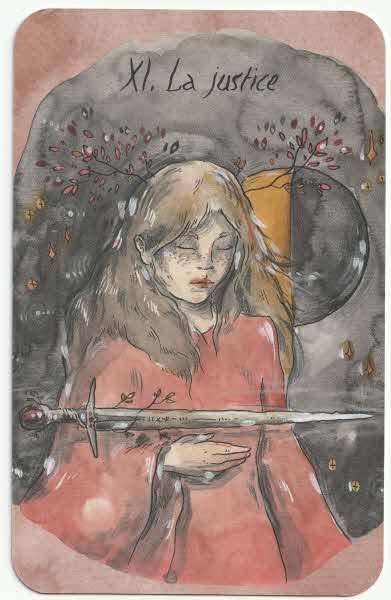

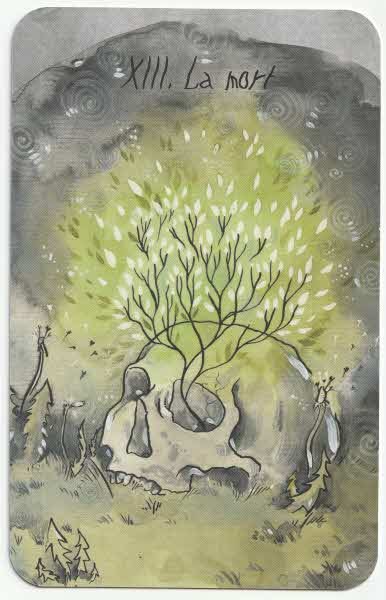
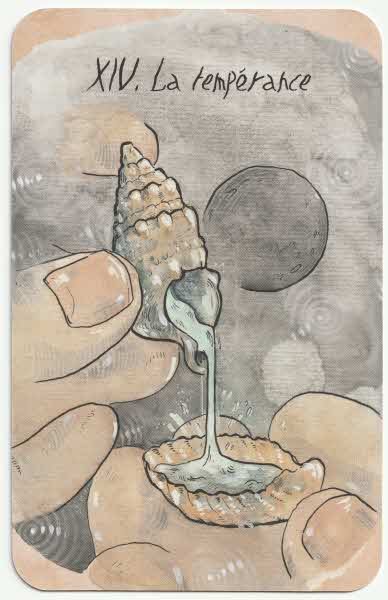

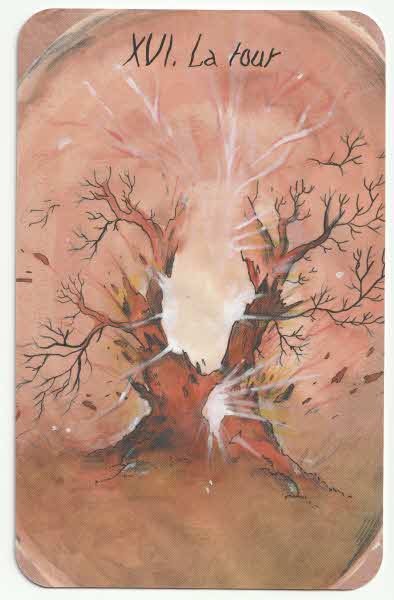
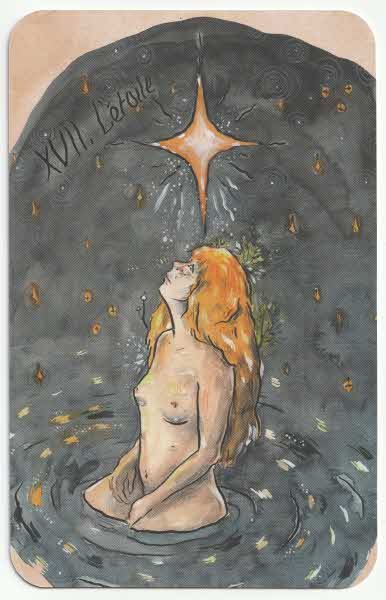
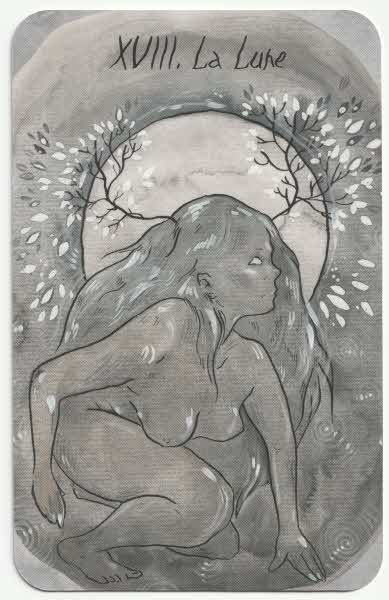
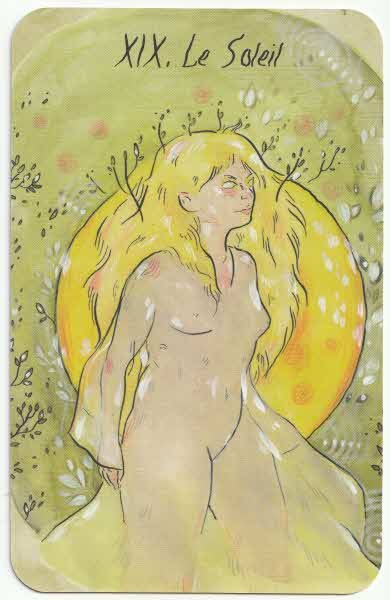
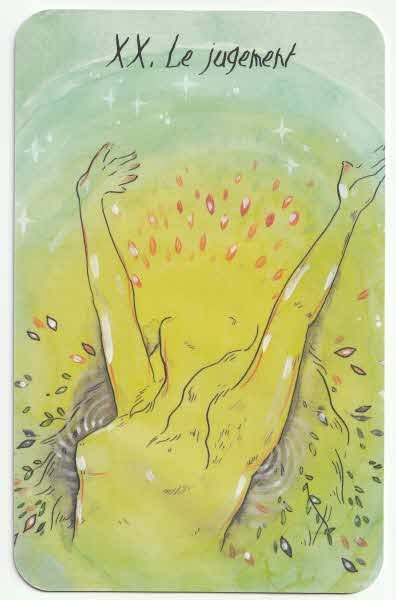
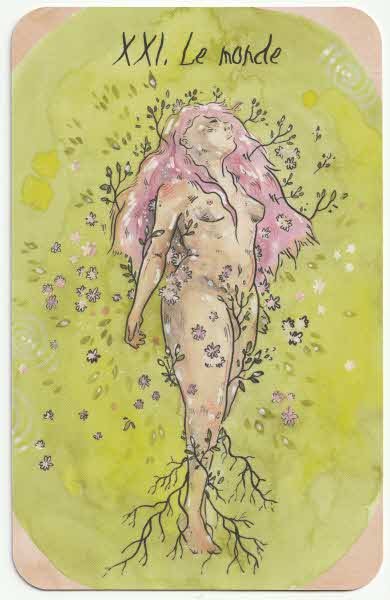
Alisa has kept several traditional elements in this card set. The main changes are that she's switched up the King to a Goddess, and added two extra cards. The people shown in the cards are mostly women, and even The Emperor looks feminine. The major arcana are lovely, as are the rest of the cards. The major arcana are easy to identify because apart from Le fou (The Fool) they’re all numbered. A strong nature theme is evident throughout. Branches, twigs or leaves are on almost every card. Many of the female characters have antlers of twigs and leaves. This is very much an earthy deck. So many cards are worth mentioning; I’ve almost half the pack to one side, and this is simply too many. The High Priestess is a stunning card, and I love how the branches come up from the pages of a book. The branches obscure the woman's face, and a waning crescent moon shines behind her. She has white hair to emphasise that time has passed, and the moon phases tells us she’s in the end phase of something. Maybe it’s a just a big fat hint at the wisdom we acquire with time; or a suggestion growth is still possible if we’re prepared to learn.
I thought I’d take a closer look at The Emperor because of the ambiguity of the figure in the card. From the guidebook: Could it be an ancient sculpture buried under centuries of history and layers of moss? Or perhaps it's the emperor himself in the flesh, no one knows at this stage. Solidly seated on an unshakeable throne, he has been immobile for a very long time. The emperor is deeply rooted in his environment; he is stability incarnate. The cross of life on his torso is a reminder of his vital force, but also of his direct link with the divine, which gave him power over the material world for the duration of his existence.
In a draw, this arcanum indicates a stable position and authority. Nothing changes under the sun, and even less so with the emperor around. It also reminds everyone of their place, with a strict, almost tyrannical hierarchy, where the emperor holds all the power. You need to draw inspiration from his determination and fighting spirit, but beware of excess. The cloak of vegetation that covers his shoulders must remain a symbol of serenity.
It’s a good interpretation, and I really like the description of the imagery; I find it helps me to understand what’s going on. The card is much easier to work with when you know the person/statue is covered in moss with branches growing from the highest point (I wondered if it was a fabric cloak or hair) . The ankh over the heart area indicates someone deeply committed to living life on their own terms. The branches symbolise life, but also new growth. Staying connected to nature is known to help calm the spirit, and emperor-types tend to be more agitated than most.
I feel a definite fondness towards The Lovers card for showing a woman on her own surrounded by wildflowers, but the card I need to look at next is The Hanged Man. From the guidebook: Hanging on the branch of uncertainty, those who ask questions have their sight obstructed and their future uncertain. But with the absence of vision, other senses develop. She takes advantage of this pause to grow, to change her point of view, to understand what has brought her to this point and to accept it. Letting go is an ordeal in itself, it's not simply a question of a great emptiness that embraces existence, on the contrary, you have to close your eyes to see better, feel better and move better thanks to your mind, which then becomes more mobile, alive... .
This card advocates acceptance. Being where you are, living in the present — whatever it brings with it — is not easy, but this learning can be extremely valuable. Waiting for the hanged man is far from futile, it's full of meaning, it's a quest in itself. Everyone is afraid of falling, and the time before the fall can last an eternity: the important thing is to understand what there was before this misstep and what there will be afterwards. You have to get to the end of a cycle before the cycle comes to an end.
I was drawn to artwork because Alisa hasn’t used a traditional image. I was curious about the eyes being covered with branches, and I like her explanation for the meaning of the card. I’m never happy to see this card in a reading for myself, but I don’t think I’d mind this one so much. I’m wondering if it’s to do with the energy of the deck. There is such a strong push for the reader to ground and connect with natural cycles.
Some of the majors I wish I had more time to eplore — The Death card is beautful and makes clear that life can grow from old bones. I’m intrigued by The Devil because the woman appears to be holding a mirror. Could this hint at vanity being a cause for concern? I love the primal nature showing in The Moon card. The woman blends in well with the rest of the card as she she crouches down. We can see the huge full moon behind her, and her antlers of branches are abundant with tiny white leaves. It’s just lovely.
Between the majors and minors, there are two additional cards. En haut (up) and En bas (down). It’s easy to remember which is which, because we have the feet for down, and a face looking upwards for up. I think they make great additions. They fit well with the overall theme of the deck. All text in bold is from the guidebook:
Up: In a bluish air, as if filled with a thick fog, branches rise silently towards the immensity of the sky. It was enough to look up at the clouds to get lost in them - who would have thought they were so close? Time seems to stand still, or perhaps it hasn't existed since the beginning. This moment of communion and wonder is one of awareness of the infinite that is within us and around us, outside the physical laws of the material world.
This card is here to remind you of all the truths that are so ancient that we sometimes forget they're there, by dint of crouching down to observe no matter what we do. It's time to reconnect with your nature of being celestial: you are made of great ideas, joy and lightness. Don't let routine take over your world, see bigger, further. It is also the map of dreamers and adventurers who have followed this advice and lost themselves for the short time of eternity... ask yourself: what kind of intergalactic traveler are you?
Down: The mother welcomes her child who has come to recharge her batteries. Their bond is so strong that the roots materialize it, uniting them to each other. To step into the present moment, to feel the earth under your feet, its pulse, is to return home. The Earth is our home for the duration of this existence, and we can never thank it enough: coming to offer it a little of our love and our happiness is the least we can do...
If you were waiting for a reminder to come down to earth, here it is: its stability is much deeper than that of a throne, nothing will surpass the strength of the roots. But the world below is also the world of fairies, earth spirits and dragons, and you are invited to join their dance! Anchoring, the present, vitality and joy of the body: the message of this card is palpable, real. All you have to do is kneel down to listen to the heart of the Earth, and feel its pulse in your chest. There are many ways to honor our mother Earth, how will you do it?
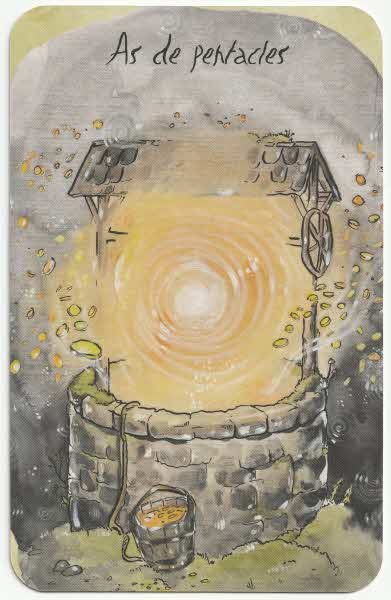
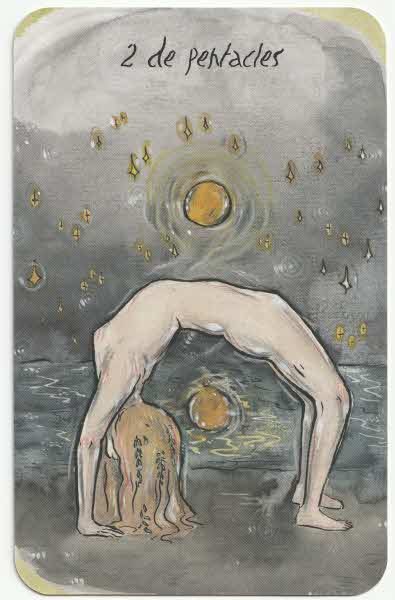
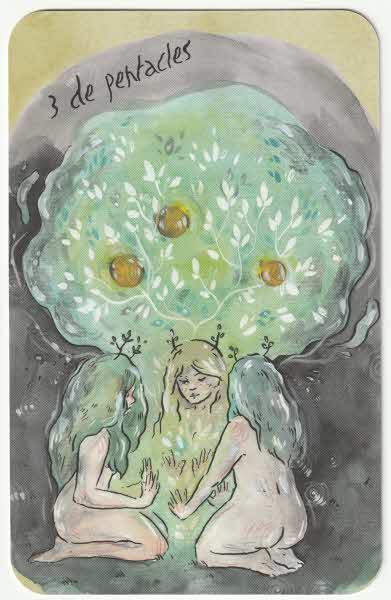
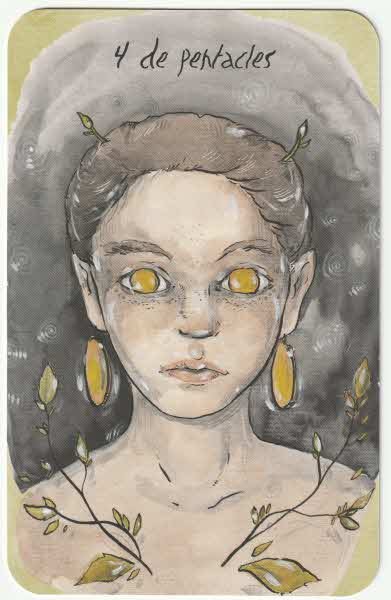
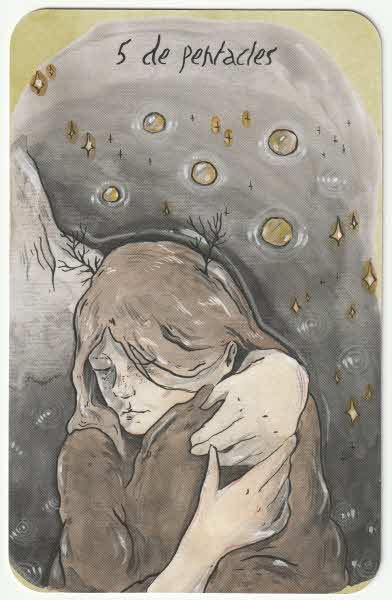
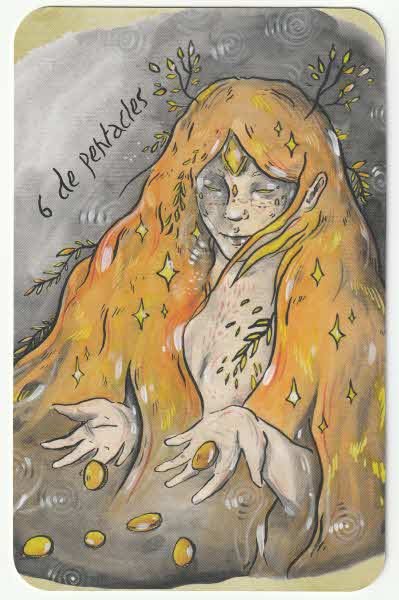

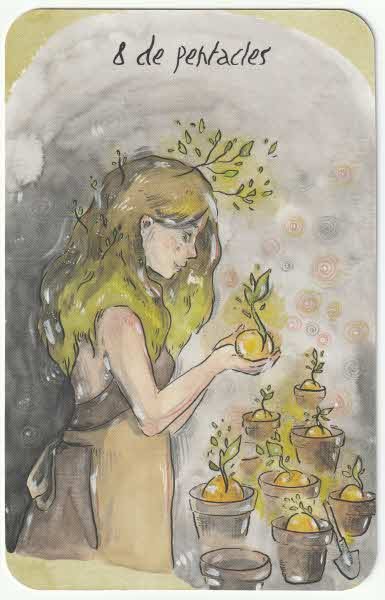
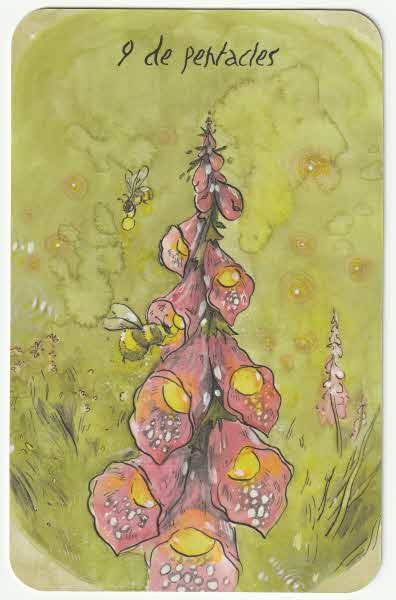
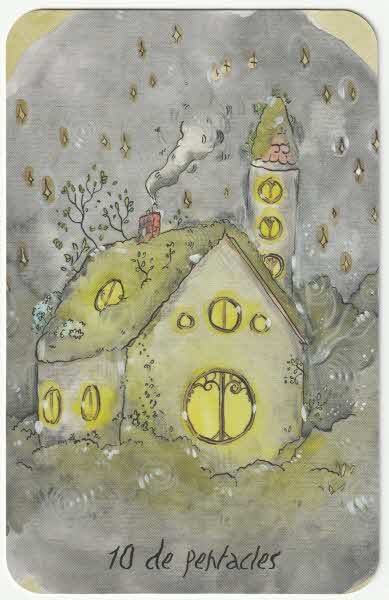
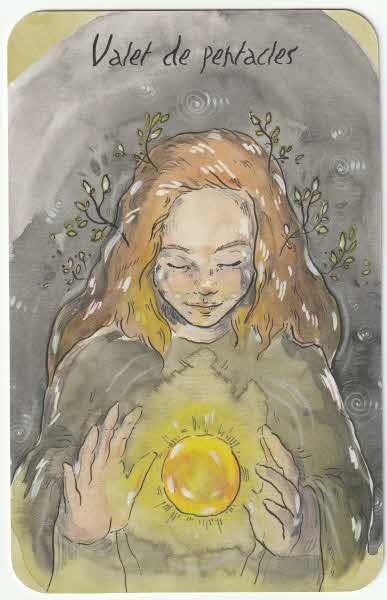


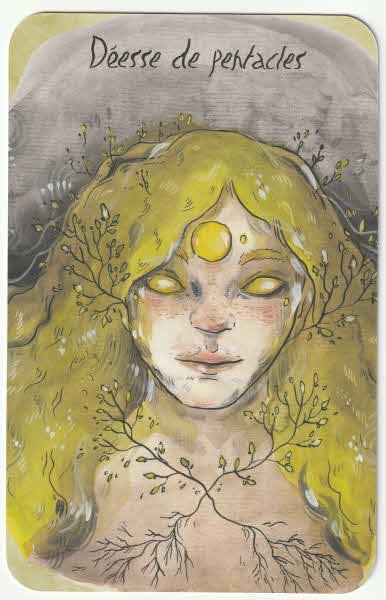
The pentacles all have the same green edging at the corners. Interestingly, all have a good amount of grey that serves as a background except for the nine of pentacles which uses green. The four of pentacles has a curious figure looking straight at the reader. The tiny antlers are just starting to show signs of life. Is that two pentacles in the place of eyes? Is money all they can see? The five of pentacles breaks with tradition only slightly. There’s a feeling of poverty from the card, but the child is receiving a hug. Someone is pulling her close to warm her — she’s not out alone in the cold. Her tiny antlers have no leaves — that’s a good symbol for lack on the physical level. The nine of pentacles stands out when placed alongside the rest of the suit, and for that reason alone I want to look at what Alisa has to say about the energy of the card. From the guidebook: A magnificent purple foxglove crowns the garden with its pink buds, offering the bees delicate pentacles of precious nectar, the vital source for making honey. The richness of this nutrient, the beauty of the place, everything is a reminder of the opulence and luxury of the place.
In a drawing, the 9 of pentacles invites you to simple material appreciation and comfort. Imagine being a little bee who has well deserved this honey in preparation for so long, rewarded for her labour. It's time to settle down and savour this delight.
I like the symbolism here. Often the nine of pentacles will represent someone who has many skills and is able to turn that skill into a business. It comes up for self-employment, craftspeople, and those who love to genuinely love to work.
For the court cards: valet translates as ‘Jack’, we have the knight (cavalier), the Queen (Reine) and the Goddess (Déesse). The Goddess of Pentacles looks wonderfully earthy. The branches almost look like veins on her chest.
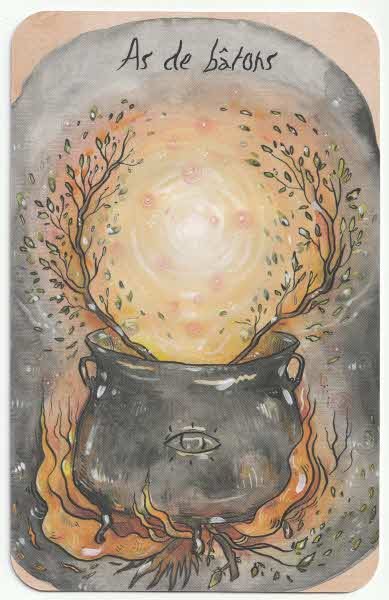
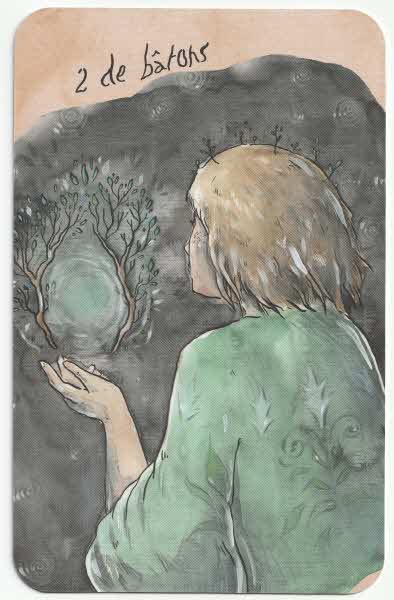
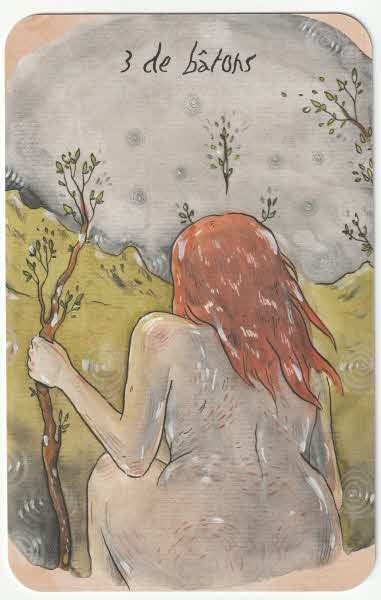
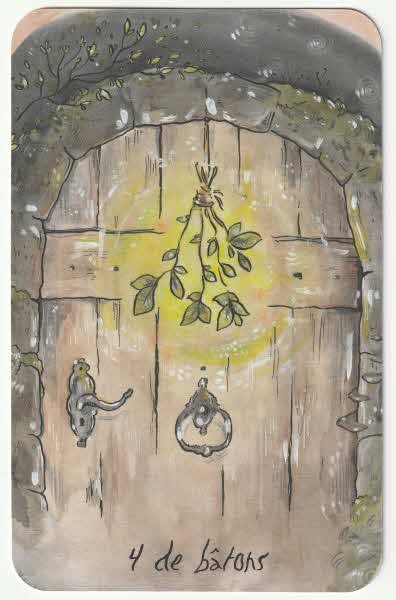
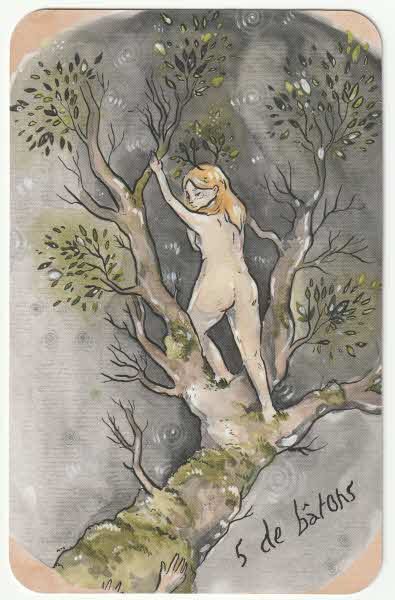
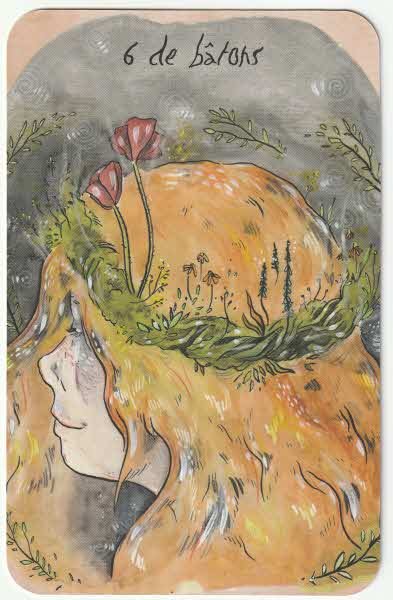
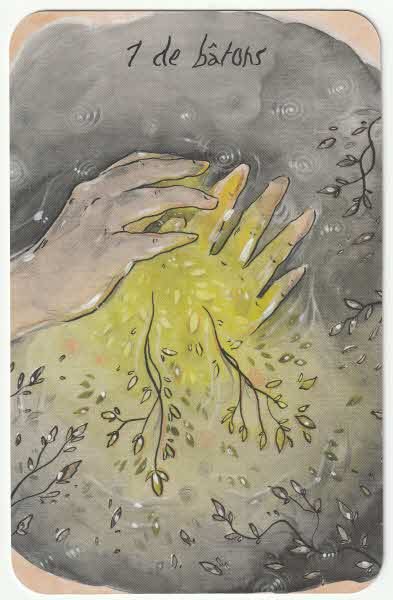
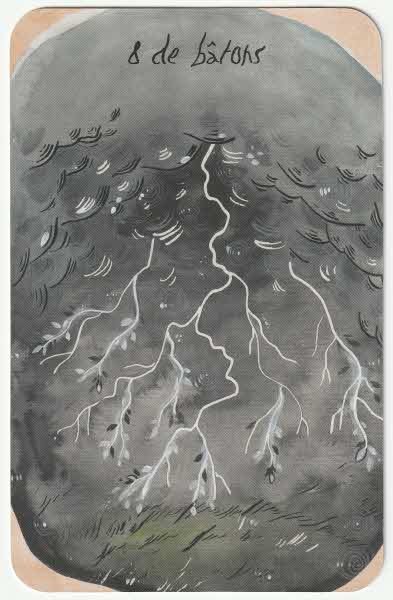


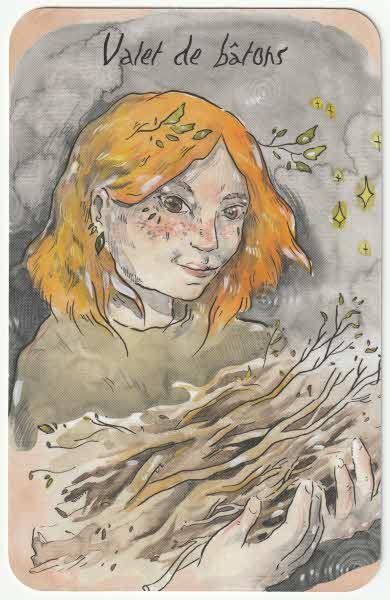
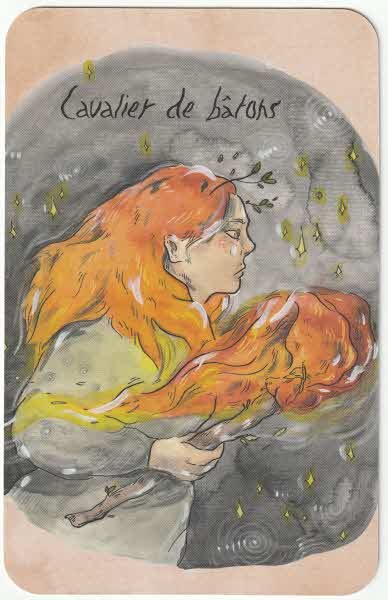
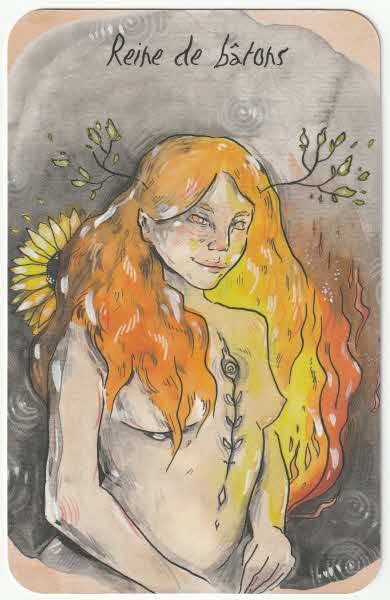
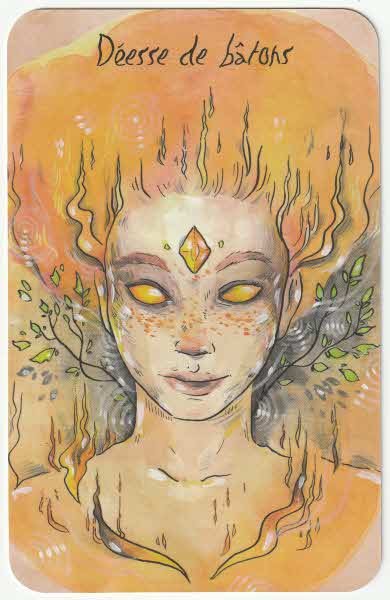
The de batons (of wands) have many lovely cards. The colours in the two of wands are perfect, and I find myself drawn to the portal-like space between the trees. Is she seeing a vision of somewhere to go? Or is it a mystical entrance to another realm? In the three of wands, she’s waiting isn’t she? She looks like she’s crouching down and getting ready to go, but she’s waiting. Her fiery red hair suggests she’ll be off like a rocket once she goes. The four of wands as a door to a home is really sweet. It’s a card I associate with one’s inner home, and often shows up to represent a house move to somewhere that feels like home. The eight of wands is a very intense card. It’s almost sword-like. The white branches come down like lightning from above. As a card that can symbolise thought-forms that border on telepathy, it’s an interesting image. The burdens are almost visible in the ten of wands. A sense of heaviness emanates from the card despite the fact she’s not carrying anything physical. Her antlers are huge, and weirdly it gives me the feeling of experience gathered. The Goddess of Wands looks incredible. Everything about her screams of the element of fire. She looks the happiest of all the goddess cards. I know the image is likely showing the fiery energy, but I’m also getting a hint of mountains and tall trees. At this point I am desperately hoping this deck will be made available in English.
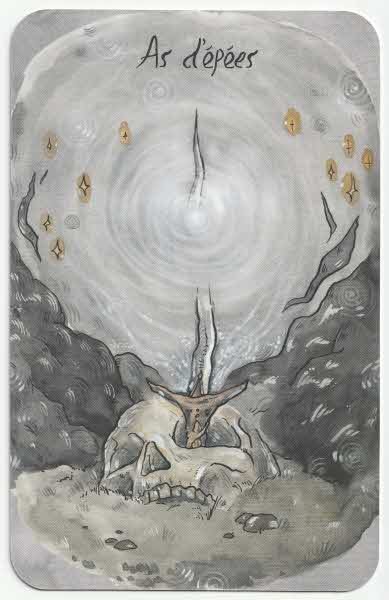
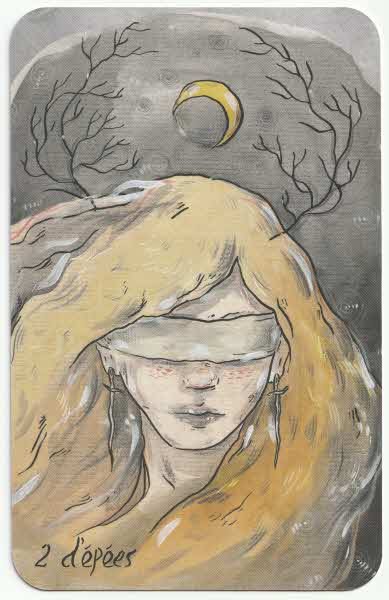

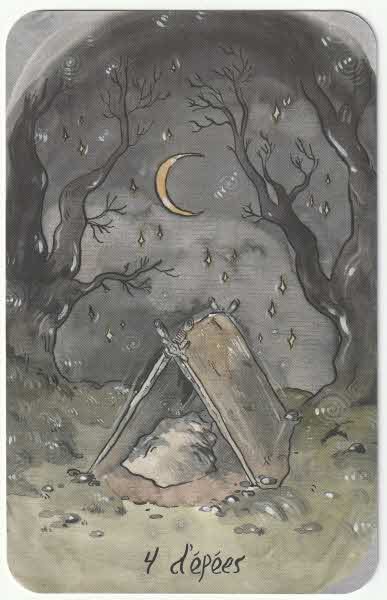
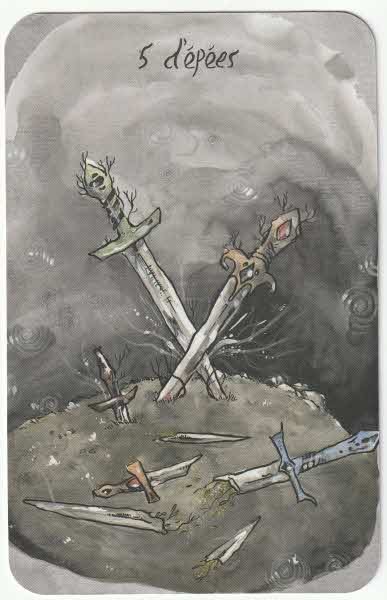


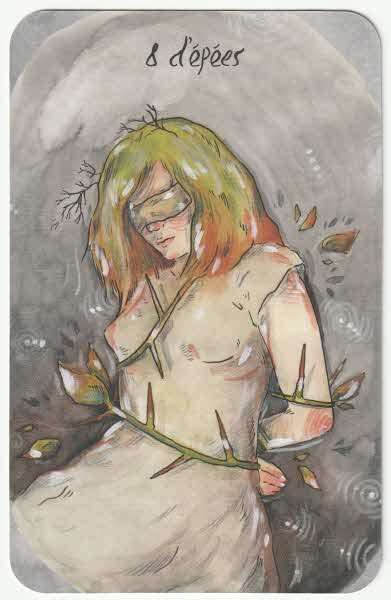
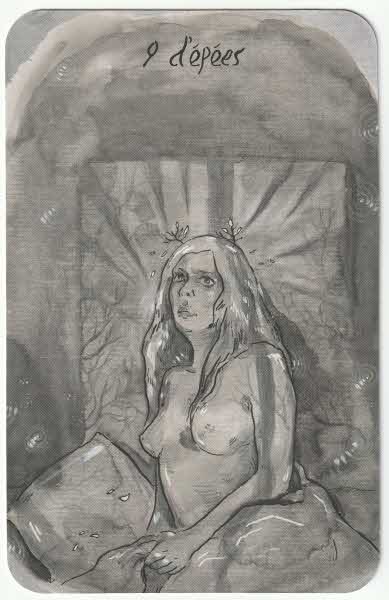
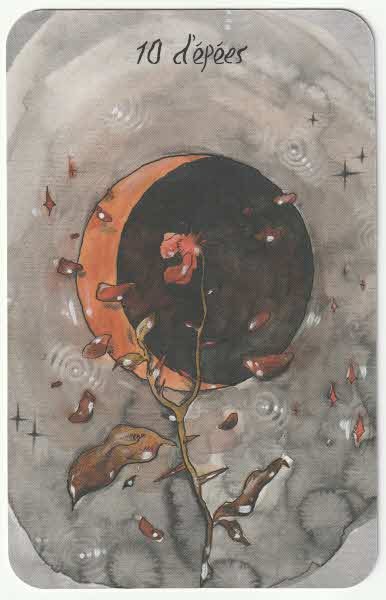
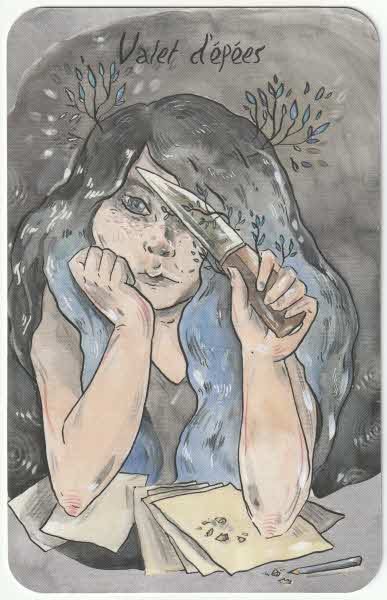
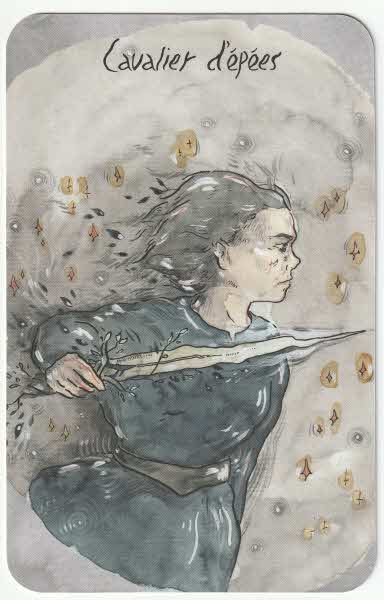
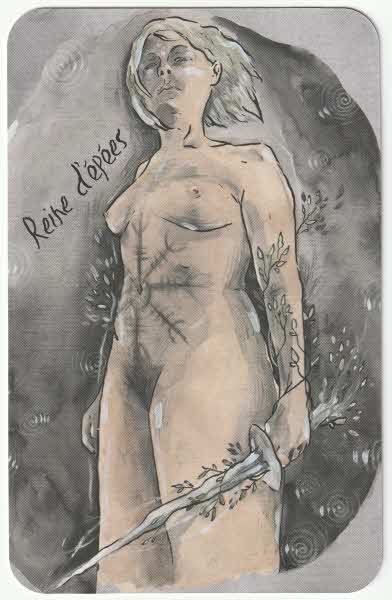
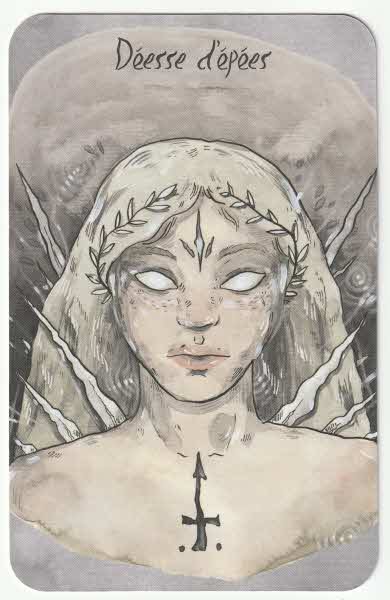
The colour grey dominates the sword cards, and there appears to be more definition in the outline of the images. They’re harsher and feel colder, and I think this captures the sword energy very well. The three of swords is symbolically strong. The swords shattering through the trunk of a tree suggest something has been damaged beyond repair. The absence of person does not make this image any easier to read. It tells us that something was growing before it was brought to an abrupt end. The seven of swords has the thief running off with five swords while two lay on the ground behind her. A classic representation of the sneaky and underhand behaviour that can be associated with this card. The eight of swords shows a woman bound and blindfolded, and this fits effortlessly with traditional interpretations.The thorny vine will make it difficult for her to escape unharmed. But, it’s maybe better to get a few scratches than stay trapped. I’m intrigued by the ten of swords and I now want to go off and translate the passage in the book. Actually, I wonder if it’s showing an eclipse? I thought at first it was a waning crescent moon, but now I’m not so sure. The thorny branch is reaching upwards with its brown leaves. Is it telling us the situation is already dead? The Goddess of Swords looks seriously sharp. She looks like she’d destroy the evil queen of Narnia in no time. I mean, seriously.
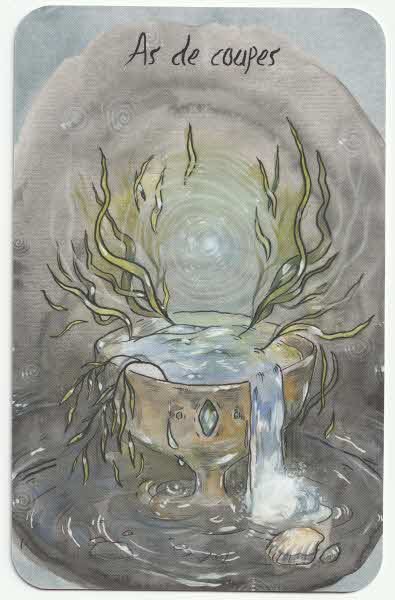
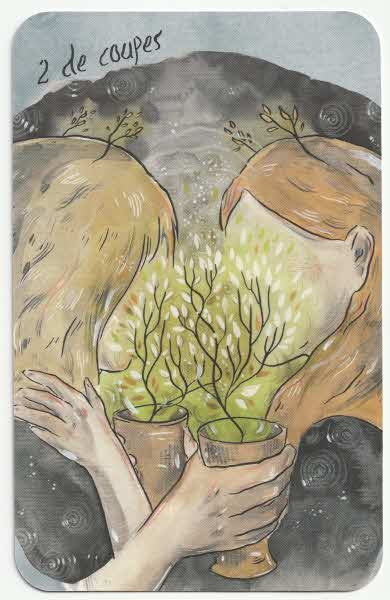
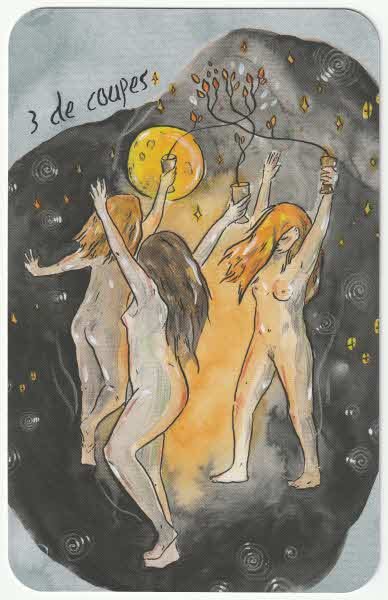
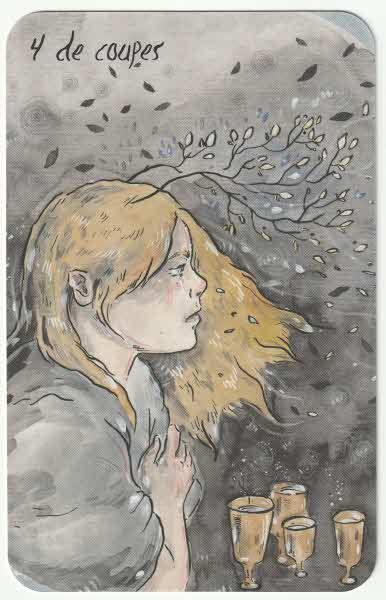
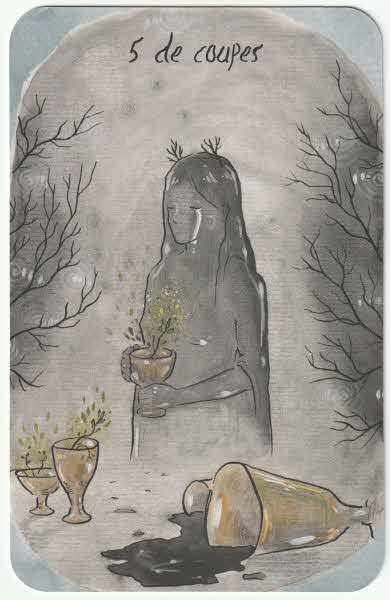
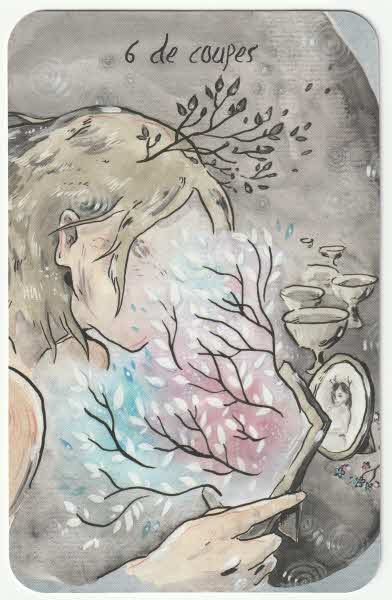
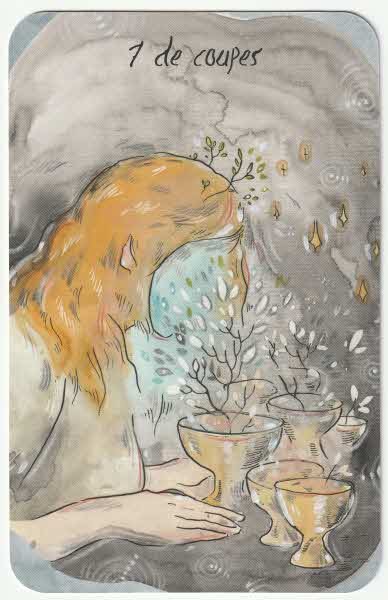
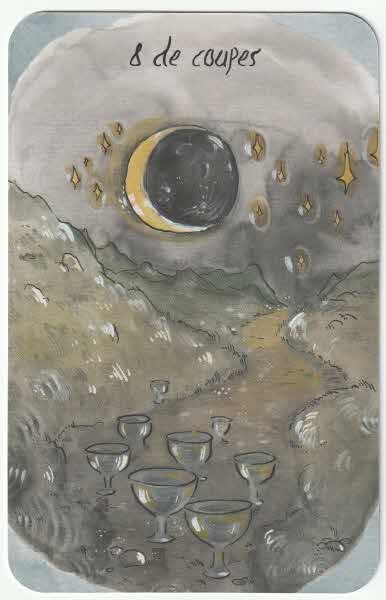

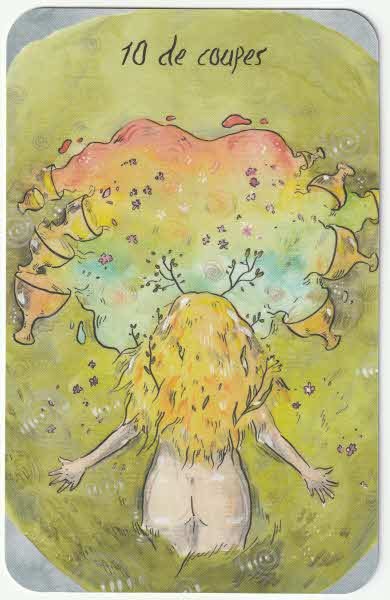
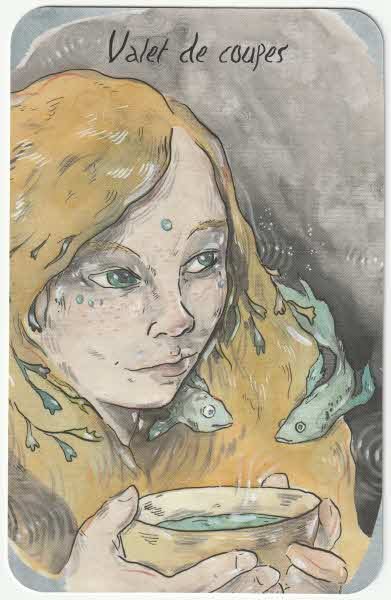
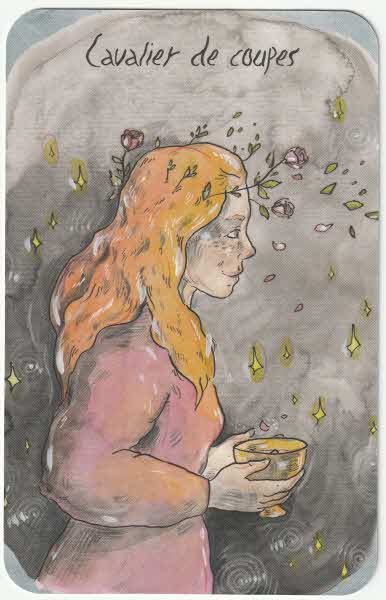
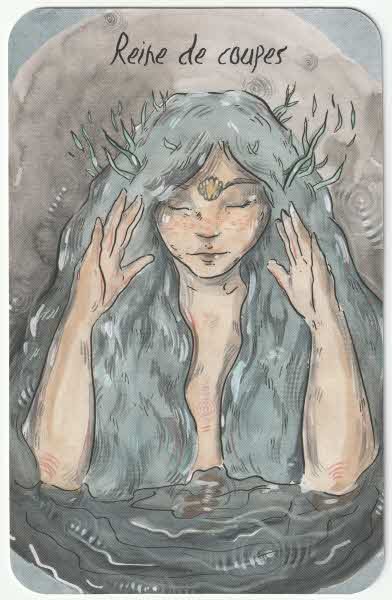

The coupes are easily recognised as the cup cards, and are by far my favourite suit. I love the shades of blue. The two of cups expresses reciprocity very well. I like the symbolism of the branches growing out of the cups too, it’s a good sign for a growing relationship. There is the essence of sadness and disappointment in the five of cups, but I really appreciate the young woman being shown entirely grey. The signs of life in the unspilt cups are reassuring. In the six of cups we have a clear reference to nostalgia and memory in the form of a photograph. The splash of colour between the woman and the photograph is a positive sign of happy feelings. The final card I want to look at closely is the Queen of Cups. I prefer this card to the Goddess of Cups, although I’m not sure why. Maybe it’s because the queen looks less tired and has better hair? I love the colours in both cards and think they capture the essence of water especially well. But let’s look at what the guidebook says about the queen: With her eyes closed, the Queen of Cups is plunged into the depths of her ocean. These unfathomable waters are her own emotions. Completely immersed, she swims in this inner world which allows her to see far beyond. Calm, benevolent, she smiles gently, in full possession of her sensitivity. This queen in your draw is here to remind you that, sometimes, you have to close your eyes to see better. Intuition must guide your choice, your heart must decide what is good. Your empathy is your strong point, open yourself to others and accept the gift of new feelings.
I’m glad I took the time to try to understand a tiny portion of what is written in the book. I enjoy the style of writing, and get the feeling it’s one of those sets that can really life you out of yourself. In some ways it reminds me of the old Faeries Oracle by Brian Froud and Jes MacBeth — and it’s not the artwork that’s doing it.
I’m fascinated by this deck and I would love to see it in English translation, because the book appears to be as lovely as the cards. I briefly thought about posting a card per day on Facebook and then remembered that thing called copyright. Generally, when I’m doing reviews, I like to think I stay within the boundary of ‘fair use’. I don’t see the point in doing a review if you can’t get a good idea of what to expect before you go off and buy something. Tarot and oracle are always sealed, with good reason, but it’s a pile of shite when you are drawn to the picture on the box and the rest of the deck or the book falls flat. The problem I’ve had with this deck isn’t that I don’t like it. I think it’s an incredibly good deck. My problem is that I want to read the whole book in a hour or two, and I can’t. I sincerely hope that if it doesn’t get picked up by an English publishing house, that Alisa will enable an English translation in pdf or something. I’ll be using these cards regularly despite them being a nightmare to shuffle. I can imagine many readers are happy to use the cards without the book, but I think it’s a real shame to miss out on the original interpretations. And yes, I bought a French tarot deck and am now complaining that the words are in French! I’m happy I bought it, and I’d buy it again if an English version was to be released.
Recent Posts
Archives
Categories
- Animal-centred
- Books
- Decks For Self-development
- Difficult Decks
- Expensive Decks
- Lenormand Decks
- Oracle Cards
- Oracle Cards For Beginners
- Out-of-print
- Personal Favourites
- Published 2000s
- Published 2010s
- Published 2020s
- Tarot
- Tarot & Oracle Sets
- Tarot Cards For Beginners
- Under £15
- Under £20
- Under £30
- Under £40
- Witchy Decks
- Woman-centred
